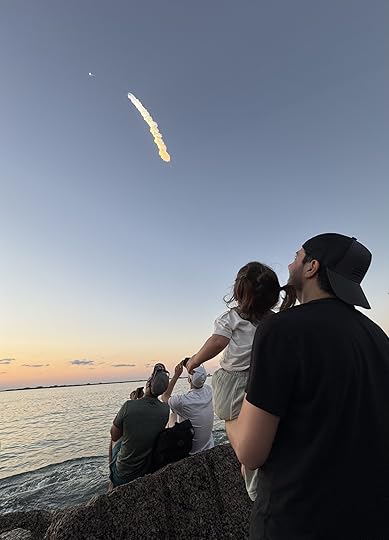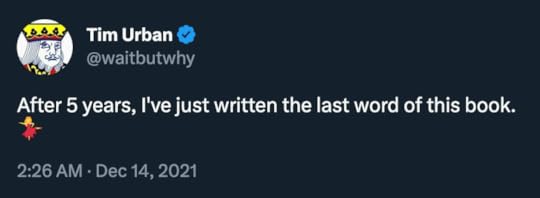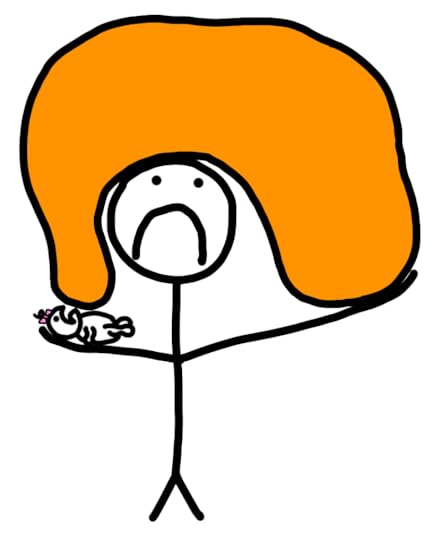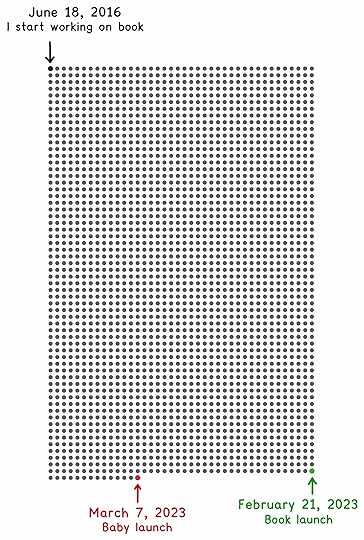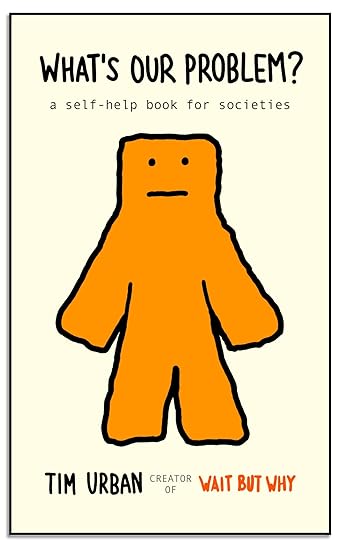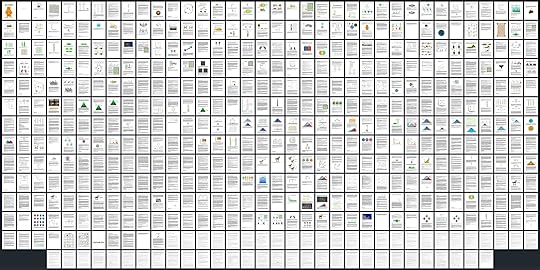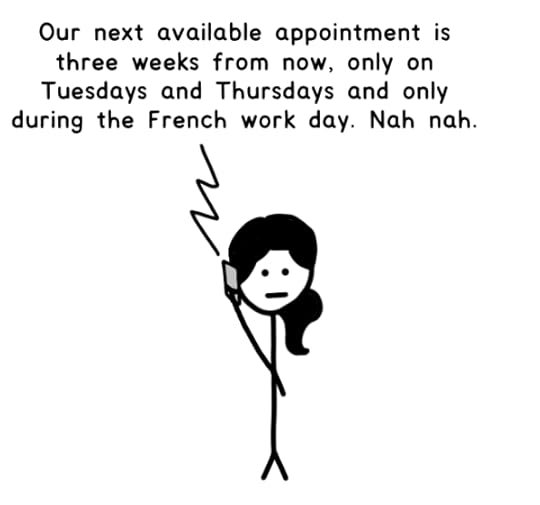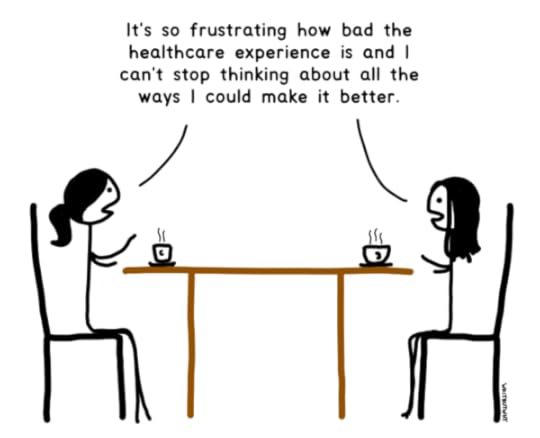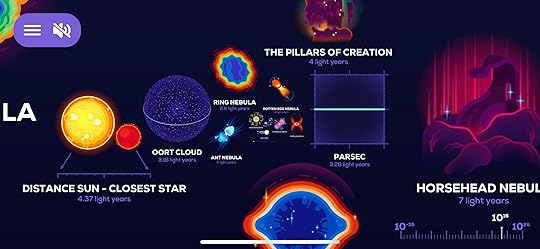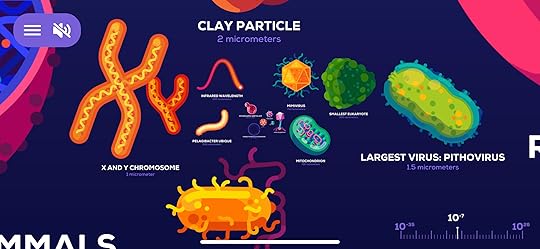Tim Urban's Blog
October 24, 2025
Tales from Toddlerhood
Back in 2023, I wrote a post about having my first baby and all the things that confused me about doing so.
Earlier this year, it happened again. Just like that, I was back here:
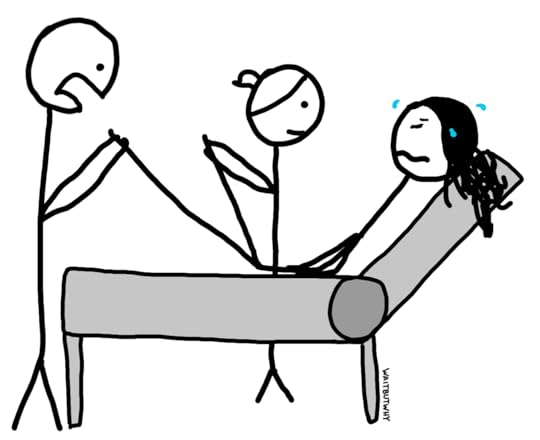
On one hand, now time doesn’t exist at all.

On the other hand, the second child is…easier than the first.
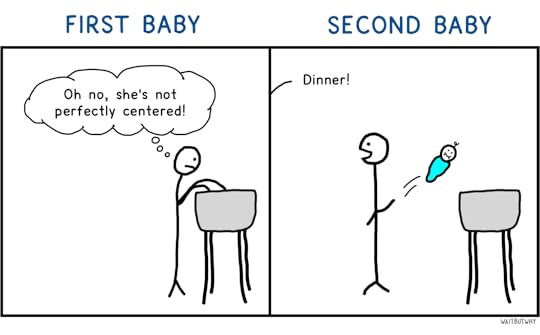
But I’m not here to talk about the new baby, delightful and obese as she may be. Today, I report to you from the depths of toddler parenthood. I always thought two-year-olds were basically unconscious blobs with a cold, but it turns out they’re actual people you can get to know. Having now spent some time cohabitating with one, I’ve made the following discoveries:
1) You can be simultaneously completely obsessed with and dramatically bored by the same person.Sometimes when I’m working in my office, my daughter will toddle in, run over to me, and give me a hug. It is by far the best part of my day. Her smile fills me with utter joy. Her little voice is sent straight from heaven. I feel the purest possible love for her.
It’s just that I also find her groundbreakingly boring. A five-minute hangout is one thing, but when I’m deep in an afternoon with her, it’s hard to come to any other conclusion than that I’ve spent my last three hours with a person whose IQ is 20.
 2) Toddlers are dicks.
2) Toddlers are dicks.It’s well-known that toddlers transform into mid-20th-century totalitarian dictators at the drop of a hat.

But they’re dicks in less obvious ways too. The other day, my toddler was playing with Legos. I sat down next to her and asked her what she was building, and she said, “Daddy needs to work in his office?”—an unsubtle hint that I should leave her the fuck alone.
Or the times I cook a whole thing for her with care and love and she refuses to take a bite, making me feel cluey for myself.
Most recently, I made the mistake of telling her my age, and now she says “Daddy is 43” like 30 times a day, constantly filling me with existential dread.
 3) No one wants to see videos of someone else’s toddler.
3) No one wants to see videos of someone else’s toddler.Toddler parenthood is a reality distortion zone that makes it hard to remember that most people find your toddler breathtakingly uninteresting.1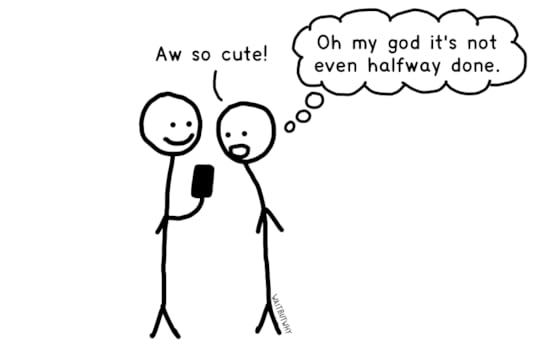
Friends who have kids the same age as yours are kind of in a cohort together, so parents of toddlers often end up with a whole throng of toddlers in their lives. Amongst my cohort I’ve both been an offender and frequent victim of toddler-video-showing. It’s part of the tax we all pay.2
I try to at least minimize the fallout from my end.
 4) Someone else’s toddler can ruin your week.
4) Someone else’s toddler can ruin your week. 5) Toddlers are geniuses who are also very dumb.
5) Toddlers are geniuses who are also very dumb.If I took my daughter to China for a year, and we just lived there with no language instruction, I’d come back knowing approximately six Mandarin words and she’d be fluent. It makes no sense to me that toddlers just learn a language by hearing the language, but somehow they do. They’re weird freak geniuses. But then she says stuff like “would you like a strawberry?” when she wants a strawberry, because when we say “you,” it refers to her, so she now thinks “you” is a synonym for her name, which is very unimpressive.
Likewise, the other day I read her a new book for the first time, and then the second time I read it to her, she stopped me in the middle to correct something I said. It turns out I had accidentally skipped a word, which she knew because she somehow memorized the whole book on the first read. But then we’ll pick up another book and she’ll stare at the page for a million years looking for where Curious George is “hiding” even though he’s obviously right the fuck there.
6) Toddlers have a highly inaccurate worldview.We sometimes take our toddler to story time at the library, where the librarian reads a book to a bunch of kids. The first time we took her, she decided to take matters into her own hands and, mid-story, went and sat in the librarian’s lap. The issue is that she hadn’t quite figured out that the world does not exist entirely for her benefit.
It’s understandable. You’re born into the world and for the first few years, everyone you see smiles and waves at you, so you overestimate your importance. Only slowly do you learn what’s really happening.3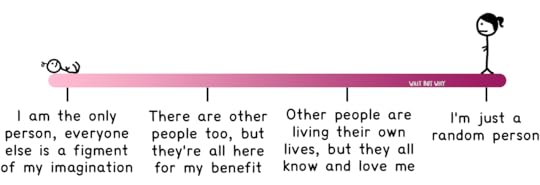
This is part of the broader phenomenon of a toddler not really having any idea what’s going on. They don’t know about death, or money, or history, or sex, or the Big Bang, or basically anything about reality. They just emerged out of nowhere and started being, which for some reason doesn’t strike them as weird or confusing.
(A good “do you have any idea what’s going on?” litmus test is: If you’re walking down the street and an elephant flies down from the sky, hovers ten feet above you and says hello in a silly cartoon voice before flying off, would you be like “OH MY GOD WHAT JUST HAPPENED” or would you shrug and be like “I guess that’s something that happens”? If the latter, you have no idea what’s going on. Most two-year-olds fail this test.)
7) Toddlers are both the funniest and least funny possible people.My daughter is remarkably unfunny. Once when she dropped something, I said “kerplunk,” and she found it fucking hilarious. For the next ten minutes, she kept picking things up, dropping them, and saying “kerplunk,” hysterically laughing each time.
But unintentionally, she’s a comedic genius. When I was in her way recently, she said, “Can you get out of space?” which my wife and I now say to each other whenever we want the other to move. Another time, we had to rip a band-aid off her leg, after which she said, “I am so perfectly sad,” and now my wife and I say that anytime we’re unhappy about something.4
We’ve also discovered an amazing hack: you can just teach a toddler to say whatever you want. We taught her to say “mamma mia” whenever she falls over, which I highly recommend to other toddler parents.
8) Toddler parents have very strong opinions and everyone is very judgy.
The problem is, for every strong opinion, there’s an equally strong opposite opinion.

I’ve taken to accepting that I’m messing up all kinds of things, and mainly just try to have fun with my little friend. To the extent that I have a strategy, it’s basically:
Spend lots of (phone-free) time with herShow her that the world is a fun and fascinating placeEncourage her to reason from first principlesDon’t interrupt her when she’s focused or daydreaming; help her learn to be entertained by her own mindRefrain from imposing lots of little rules, but where there are rules, be firm about themBuild problem-solving confidence, teaching her to become a person who says “I want to figure out the directions” instead of a person who says “let’s just ask someone”Toddler parents can take solace in the fact that parenting probably matters less than we think it does. Rather than try to shape our little two-foot-tall companions, we should help guide them to become the best version of who they already are.
Anyway, gotta go. Time to read Squeak the Mouse Likes His House for the 57th time.
___________
More tales from fatherhood: 10 Thoughts from the Fourth Trimester
My favorite toddler books: Flotsam, Little Fur Family, The Giant Jam Sandwich, Little Owl’s Night
If you’d rather read about something other than my fat babies:
The Marriage Decision: Everything Forever or Nothing Ever Again
Taming the Mammoth: Why You Should Stop Caring What Other People Think
_______
If you like Wait But Why, sign up for our email list and we’ll send you new posts when they come out.
To support Wait But Why, visit our Patreon page.
Toddler grandparents may be an exception, though they span a wide range, from “Please go away for a month and leave them with me” on one end, to “I will play with them for five minutes but only because it looks bad if I don’t” on the other. Those on the latter end are as bored by toddler videos as everyone else.↩
There’s a range here. A short, high-quality video of a good friend’s toddler, sent by text (so you can watch on your own time and don’t have to react the whole time) is fine—nice even. A person you barely know showing you a long toddler video, in person, is a nightmare.↩
Some have suggested that the common desire for fame is, in some subconscious sense, an attempt to recapture the long-lost feeling that the whole world knows and loves you.↩
She actually said “Can I get out of space?” and “You are so perfectly sad” because, again, she is confused about pronouns.↩
The post Tales from Toddlerhood appeared first on Wait But Why.
October 16, 2024
Why I Lugged My 27-Pound Toddler to a Rocket Launch
This post was originally published in The Free Press on October 14, 2024.
Last night, I received two texts from Bari Weiss:
Any interest in writing a short piece about that jaw-dropping launch?
And why you brought your daughter to see it?
The first question is an easy one. I’ve been fascinated by space ever since I gained sentience sometime in the mid-1980s. I had the order of the planets down by age four, and a few years later I could (and did) tell people that you could fit a thousand Earths inside Jupiter and a thousand Jupiters inside the sun.
I remember being amazed watching videos of the moon landing—but also confused. The cars, telephones, TVs, and computers of my childhood were worlds more advanced than anything my parents had as kids. But with space, the normal order of things was reversed: My parents grew up exhilarated by Apollo missions to places no man had gone before, while I was watching the space shuttle take astronauts a little hop above Earth’s surface to do some technical work on the International Space Station. I remember feeling a deep envy of people who were around in the 1960s. It didn’t make sense.
The problem turned out to be this:1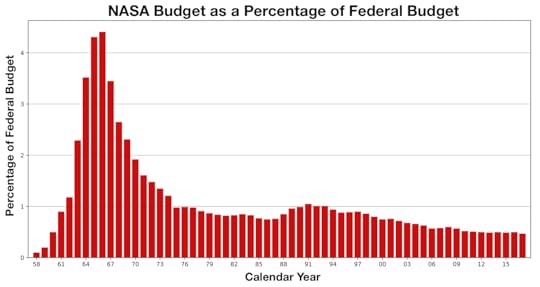
People living in the 1960s thought the moon landing was just the beginning. By 2024, they’d have imagined, there would be a permanent moon base, lots of space tourism, and even people walking around on other planets.
As it turns out, the 1960s were a fluke. It was the height of the Cold War and “desperate times call for desperate measures” justified all kinds of unusual behaviors—including spending five percent of the federal budget to one-up the Soviet Union in the space race. That brief spike in space expenditure put a man on the moon, captivated all of humanity and reminded us of what’s possible when we put our minds together.
Then the Cold War moved on, shifting its tensions to other arenas. Space became less of a critical mission and more of a fun hobby. What had been five percent of the federal budget in the mid-1960s dropped to one percent by the mid-1970s and 0.5 percent in recent decades.
Any hopes I had that the U.S. would decide to become rad about space again were dashed in 2011, when the space shuttle program was shut down for good. Now we couldn’t even launch astronauts into low Earth orbit. When we wanted to send Americans into space, we had to politely ask Russia to do it for us.
I get it. We have many more pressing needs than space. A politician campaigning today on dedicating five percent of the budget to space would be laughed out of the room.
It’s just that it’s such a shame. The moon landing was a tantalizing glimpse into the incredible potential of our species—and a frustrating reminder that without desperate times, that potential remains largely untapped.
Then came SpaceX. I first heard about it in 2012 when 60 Minutes did a segment on the company. Over the next few years, I watched as SpaceX kept defying expectations, successfully launching progressively bigger and more legit rockets into orbit.
In what is still the most surprising day of my life, one day in 2015 Elon Musk reached out to me, said he had read my recent blog post on AI, and asked if I’d be interested in writing about SpaceX. Over the next few months I visited the SpaceX facilities, looked at their rockets up close, interviewed dozens of their engineers, and talked with Musk about the big vision for the company. I wrote about it all in a big blog post.
At the time, SpaceX was singularly focused on one of the space industry’s holy grails: rocket reusability.
Imagine if every commercial airplane flight ended with the passengers parachuting to the ground and the plane crashing into the ocean. With every plane flying exactly once, a brand-new plane would be needed for every flight. Tickets would cost millions of dollars, limiting air travel to billionaires and governments.
Until recently, that was how space travel worked. Every rocket flew once, making space available only to billionaires and governments. What if, somehow, rockets could be like planes, ending each mission by landing instead of crashing the rocket? Each rocket could be used hundreds of times instead of once, dramatically cutting down the price of space travel and revolutionizing the industry.
In late 2015 a SpaceX rocket launched, sent its payload into orbit, and for the first time in human history, came back down and landed. I watched from SpaceX headquarters. The cheer was so deafening you could feel the vibration move through your body. In the face of a million doubts, SpaceX showed that a private company could not only launch rockets but do it better than any government ever had. Soon, the U.S. government was using SpaceX, not Russia, to launch its astronauts.
But reusability was just a stepping stone on the way to SpaceX’s real mission: colonizing Mars. If you have critical information stored on a hard drive, it’s common sense to back up the info on a second hard drive. That’s how Elon Musk views humanity. We currently have all our eggs in one planet. To give our species the best chance of survival in the long run, he believes, we should live on multiple planets. We’re fortunate to have another potentially livable rocky planet nearby. Why not try to use it?
Bringing people to Mars requires a rocket far larger and smarter than any we had ever built. So SpaceX built Starship, a beast the height of a 40-story skyscraper.2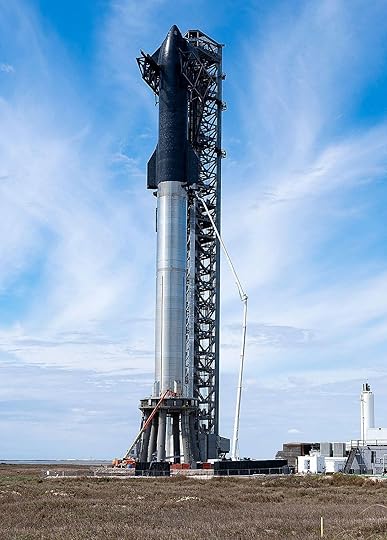
To make trips to Mars affordable, the rocket has to be reusable, which means this thing has to land. So SpaceX got busy innovating, designing a system to catch the landing rocket between two giant arms. Last week, SpaceX announced that on Sunday, October 13, they would perform Starship’s fifth test launch and, for the first time, attempt to catch the gargantuan rocket on the way down.
I knew one thing: I sure as shit wasn’t going to miss this. I made arrangements to travel to Boca Chica, Texas, to watch.
So the answer to Bari’s first text was easy. I love writing about anything related to space. Yes.
But how about the second text?
And why you brought your daughter to see it?
Let me first say that “daughter” is generous. What I have is a little two-foot-tall, 19-month-old gnome. Many times over the course of the weekend journey, I asked myself the same question. Why did I decide to bring a toddler with me?
I asked myself that question at 6:30 a.m. Sunday morning while making the 30-minute walk down the beach from the hotel to the viewing spot, which would have been much easier without lugging a fussy, under-slept, 27-pound medicine ball with me—all for something she won’t begin to understand or appreciate or remember.
We arrived at our spot and waited. Then, suddenly, the bottom of the rocket exploded into color. The launch began in silence for a few seconds while the roaring sound zipped along the water toward us. Then it got loud. My daughter hated it, saying “No?” repeatedly, which is her way of pleading with me to make it stop.
But soon, like everyone else, she was staring wide-eyed at the flying skyscraper as it bored its way upward through the thick atmosphere, painting a beautiful strip of vivid white and orange cloud across the clear sky. Way above us, we watched it separate into two little dots: The spaceship heading around the world with plans to crash into the Indian Ocean, and the rocket that was—somehow—turning around and coming back toward us.
I can say with confidence: Watching a skyscraper falling from the sky is one of the most surreal things I have ever seen. Noticing my daughter still fixated on the cloud, I redirected her attention to the falling rocket. Near the ground, with a new streak of fire shooting out of its engines, it slowly hovered its way over to the tower and into the gentle embrace of the robot arms. The crowd roared. My wife, who gives one percent as much of a shit as I do about space, was in tears.
It’s hard to wrap your head around SpaceX’s mission. If they actually succeed in putting a single human on Mars, let alone their goal of a million people, it will be one of the major milestones in not just human history but life history—on par with the moment animals first began to walk on land. Whether or not they end up pulling it off, space is officially exciting again.
But the reason rocket launches make people emotional isn’t about that. It’s the feeling of swelling pride that comes from being in awe of your own species. It’s the feeling of hope that comes from being reminded of our insane potential when thousands of people work together toward a goal. It’s the happy version of the post-9/11 feeling of wanting to hug every stranger you see.
These emotions are especially refreshing at a time when we’re surrounded by their polar opposite: the pessimism and petty cynicism that pervade our age of suffocating tribalism.
As the father to a smiley little gnome, I desperately want to shield her from the negativity that will swirl around her as she grows up. I won’t be able to do that. But what I can do is continually redirect her attention to the rocket, showing her all the ways our species is incredible. I can use “rocket launch emotion” as a parenting compass and try, as many times as I can, to give her experiences that fill her with that particular magical, high-minded feeling.
If along the way I also train her to be my little space nerd friend, all the better.
_______
If you like Wait But Why, sign up for our email list and we’ll send you new posts when they come out.
To support Wait But Why, visit our Patreon page.
_______
More Wait But Why space nerdery:
How (and Why) SpaceX Will Colonize Mars
4 Mind-Blowing Things About Stars
Wikipedia↩
Image: Britannica↩
The post Why I Lugged My 27-Pound Toddler to a Rocket Launch appeared first on Wait But Why.
June 28, 2024
The 2024 Trump-Biden Debate
DEBATE TRANSCRIPT:
Jake Tapper: Welcome to the CNN Presidential Debate. I’m Jake Tapper.
Dana Bash: And I’m Dana Bash. Let’s get started.
Tapper: We’ll begin with the economy. President Biden, since you took office, inflation has slowed but prices remain high. What do you say to voters who feel they are worse off under your presidency than they were under President Trump?
Biden: Look at what Mr. Trump left me when I became president. We had an economy in free fall. Everyone was unemployed. Thousands were dying of Covid, it was like a zombie apocalypse, and Trump was just drinking bleach. Then I came to office and put the pieces back together. We brought insulin shots down to 15 dollars. Senior citizens pay no more than 200 dollars a year for healthcare.
Tapper: Mr. Trump?
Trump: We had the greatest economy in the history of this world or any other world. There are some great fictional worlds out there, like the Emerald City, which by the way has a great economy, but not as good as ours. No economy had ever done as well as ours did when I was in office. Everybody was amazed by it. All the other countries said they wished I was their president. In Asia or Europe or Peru, go ask them and they’ll tell you how amazed they were by the job I did. Inflation is killing us.
Biden: A better economy than the Emerald City? I don’t know anyone who thinks that. My friend who I talked to the other day doesn’t think that. He said you were a worse president than Herbert Hoover, and that’s saying something because Herbert Hoover could give a rat’s ass who shows up at the local gooseberry growing contest. I don’t know what happened at last year’s contest but those are some good gooseberries. When Trump was president we were still killing people in Afghanistan. I’m the only president where no one has died anywhere in the world.
Tapper: Mr. Trump, you say you want to extend the tax cuts you put in place. With the U.S. facing trillion dollar deficits and record debt, why should top earners and corporations pay even less in taxes than they do now?
Trump: The tax cuts are why we had the greatest economy in human or animal history. I was just about to zero out the debt when Covid hit. So instead I made the vaccine, and it was a tremendous vaccine, and then he took over and did a very poor job. When I was president the whole world loved America and admired me. Now we’re a disgusting piss-covered Third World country.
Biden: I’m going to fix the tax system. We have a trillion thousandaires in this country—excuse me, a million trillionaires. Billionaires pay only $150 in taxes. I paid more than that when I worked at Padula’s ice cream stand when I was 15. I paid the taxes I owed. If billionaires paid their fair share we’d be able to wipe out the debt. We’d be able to pay for childcare, eldercare, healthcare. We’d be able to make every single solitary person eligible for what I’ve been able to do with, dealing with everything we have to do with everything that we have to be able to deal with.
Trump:
Tapper:
Bash:
Biden: The.
Trump:
Tapper:
Bash:
Biden: We finally beat Medicare.
Tapper: For fuck’s sake. Okay let’s talk about Roe v. Wade.
Trump: Everyone wanted to overturn Roe v. Wade, and I mean everyone. And I did that. These people are sick. They want to abort eight-month fetuses. Nine-month fetuses. Newborn babies. Older fatter babies. Boddlers. Toddlers. There’s no one these people won’t abort. President Biden tries to abort his political opponents. It’s a disaster.
Bash: President Biden?
Biden: It’s ridiculous to say everyone wanted to overturn Roe v. Wade. I didn’t. My friend didn’t. The women didn’t, including that one who was murdered by an immigrant. He went to the funeral. But here’s the deal. There’s a lot of women raped by their in-laws, by their spouses, by their brothers and sisters, by their children and grandmothers, it’s ridiculous, I saw this one video where the pool boy came into the house looking all sweaty and asked for a glass of water, and you know how that goes, you’ve seen the videos, and then they can do nothing about it and they try to arrest them when they cross state lines.
Tapper: President Biden, on the issue of border security, a record number of migrants have illegally crossed the southern border on your watch. Why should voters trust you to solve this crisis?
Biden: I hired more border patrol. I hired more asylum officers. This is why there are no more illegal immigrants. He put babies in cages. I’m going to continue until we get the total initiative relative to what we’re going to do with more border patrol and more asylum officers eating a salami on Wednesday.
Trump: I have no idea what the fuck he said at the end there and I don’t think he knows what he said either. Look, we had the safest border in the history of borders, and then he just opened them right up. He opened them to prisoners and lunatics and rapists and child molesters and terrorists and wildlings and white walkers. These are not good people. We had the safest border in history according to border patrol who, by the way, endorsed me for president, I won’t say that here but they endorsed me, I won’t talk about it but it was Brandon, Brandon from border patrol endorsed me, I won’t mention his name here but it was Brandon R. Knight who lives at 246 Longmeadow Drive in El Paso with his dogs, beautiful dogs by the way, it was the safest border and now we have the worst border in history. And these migrants are staying at the best hotels, great five-star hotels, while our veterans are on the street because he hates veterans.
Biden: Okay everything he just said is a lie. For example, I don’t hate veterans, I’d give my life for a veteran. I’d give a veteran a handjob in a Denny’s bathroom. We’ve done more for veterans than anyone in American history.
Bash: Let’s talk about Russia and Ukraine. Former President Trump, Vladimir Putin says he’ll only end the war if he gets to keep some of Ukraine and Ukraine stops trying to join NATO. Are Putin’s terms acceptable to you?
Trump: Our veterans can’t stand Biden. They think he’s the worst commander-in-chief that we’ve ever had. They wouldn’t take a handjob from him in a Denny’s bathroom even if they were desperate. If we had a real president, Putin never would have invaded Ukraine. And Hamas never would have attacked Israel. When I was president, Hamas liked Israel. You know those silly little caps Jews wear on their head? When I was president, Hamas wore those caps too. Out of respect for me. President Biden is like a Palestinian, and not one of the good ones either, he’s a bad one, he’s a weak Palestinian, he’s not even one of the scary Palestinians, he can’t even yell “Allahu Akbar” correctly and the other Palestinians can’t stand him, they can’t stand this guy.
Biden: I’ve never heard so much malarkey in my life. I’m a great Palestinian.
Bash: Former President Trump, would you support the creation of an independent Palestinian state to achieve peace in the region?
Trump: I make great deals. I made great deals as a kid. As a teenager. As an adult. As an old man. I made NATO put up biyyons and biyyons of dollars. I told them, if you don’t pay, I don’t play. And you know what happened? Biyyons and biyyons of dollars came flowing in the next day. But now we’re paying everyone’s bills again.
Tapper: Mr. Trump, I want to talk about January 6th. After you rallied your supporters that day, some of them stormed the Capitol. As president, you swore an oath to preserve, protect, and defend the Constitution. What do you say to voters who believe you violated that oath on January 6th and worry that you’ll do it again?
Trump: Let me tell you about January 6th. On January 6th, we had a secure border. On January 6th, we were energy independent. On January 6th, somewhere out there, a little boy had his first hamburger because we had made America great.
Tapper: Please answer the question.
Trump: I had nothing to do with anything that happened on On January 6th. Even Nancy Pelosi said that. She said, “President Trump had nothing to do with January 6th, it was all my fault.”
Biden: He’s a convicted felon.
Trump: His son is a convicted felon.
Biden: He had sex with a porn star in the other room while his wife was giving birth. He has the morals of an alley cat.
Alley cats: wtf
Trump: I didn’t have sex with a porn star in the other room while my wife was giving birth, she had sex with me.
Biden: He said fine people on both sides.
Trump: No I didn’t.
Biden: Yes you did. He said Hitler has done good things.
Trump: Only some.
Bash: President Biden, black Americans are struggling. What do you say to black Americans who are disappointed you haven’t made more progress?
Biden: I’ve helped black Americans in all kinds of ways. It’s inflation that’s hurting them, not me.
Trump: You caused the inflation.
Biden: I know you did but what did I do?
Bash: President Trump, will you do anything to slow the climate crisis?
Trump: The blacks love me. They made me an honorary black.
Bash:
Trump: When I was president, I had stopped climate change. I had the best environmental numbers in history.
Biden: I passed the most extensive climate change legislation in history. Blacks love me. I built labs in historically black colleges so they could do science like white colleges.
Trump: Illegals are destroying our country.
Biden: And by the way.
Biden:
Tapper: Mr. Trump, the average cost of childcare in this country has risen past $11,000/year per child. In your second term, what would you do to make childcare more affordable?
Trump: He’s the worst president in this history of this country.
Biden: He’s the worst president in this history of this country.
Trump: He’s the worst president in this history of this country.
Biden: He’s the worst president in this history of this country.
Tapper: Mr. Trump, the question was about childcare.
Trump: He’s the worst president in this history of this country.
Biden: He’s the worst president in this history of this country.
Tapper: Mr. Trump, what will you do to address the opioid crisis?
Trump: China.
Tapper: Mr. Trump, what will you do to address the opioid crisis?
Trump: Illegals are killing this country.
Tapper: Mr. Trump, what will you do to address the opioid crisis?
Trump: Democrats pay too much for hostages. I pay almost nothing.
Bash: K. President Biden, frankly you’re old as cock. How do you address concerns about this?
Biden: I used to be young. America is a great country.
Bash: Former President Trump, you’re also appallingly old. How do you address the same concerns?
Trump: I just won two club championships. To do that you have to be smart and you have to be able to hit the ball a long way. He couldn’t hit a ball 50 yards. I have the body and mind of a 23-year-old.
Biden: I’m a six handicap.
Trump: My tits you are.
Biden: I’m an eight handicap.
Trump: I’ve seen your swing.
Bash: Mr. Trump, will you pledge to accept the results of this election and say political violence of any form is unacceptable?
Trump: Of course political violence is unacceptable. I hated when Nancy Pelosi ushered in all those people to the Capitol on January 6th. I’m running because he’s the worst president in the history of this country.
Bash: Mr. Trump, will you pledge to accept the results of this election?
Trump: Putin never would have attacked Ukraine if I had been president.
Bash: Mr. Trump, will you pledge to accept the results of this election?
Trump: If the election is fair and free and I win of course I’ll accept the results.
Biden: Whiner.
Trump: Complainer.
Tapper: It is blessedly now time for the candidates to deliver their closing statements. Time for the big, lofty, heartfelt speech.
Biden: I didn’t raise taxes on most people. He instituted a 10% tariff, which is the same as raising taxes. He wants to make it so we can’t negotiate with big pharma companies. We got it down to $35 for insulin, which is $20 more than I said earlier in the debate, and a $2,000 cap for senior healthcare spending, which is ten times the figure I said earlier tonight. That’s huge progress in just a couple hours.
Trump: This guy sucks. All he does is let people pour in over the border. We’re living in a hellish rat’s nest. No one likes you. No one respects you. God I’m good. No one’s ever seen anything like it before. We live in a shit country. Because of you, I need to make America great again again.
Bash: Thank you I guess.
_______
More places to go:Presidential debate transcripts from 2020 and 2016
My book about how our politics got to this state
The American Presidents: Washington to Lincoln
_______
If you like Wait But Why, sign up for our email list and we’ll send you new posts when they come out.
To support Wait But Why, visit our Patreon page.
The post The 2024 Trump-Biden Debate appeared first on Wait But Why.
February 9, 2024
All My Thoughts After 40 Hours in the Vision Pro
I’m writing this on a 30-foot screen on top of a 10,000-foot mountain in Hawaii, at a table in an Austin coffee shop where I’m pretty sure other people are taking photos of me to send to their friends so they can all call me a piece of shit. In the last week, life has gotten weird.
My journey to the Haleakalā shield volcano Austin coffee shop began more than 30 years ago, in 1990, when my parents brought me to something called a “virtual reality exhibit” at the Seaport World Trade Center in Boston. I stood on a little circular pedestal, and the guy handed me a plastic gun and put a big headset on me. Suddenly I was in some cartoon world, in a military uniform, holding a real gun. The person on the pedestal next to me was there, also a cartoon, also holding a gun. After some janky waving and shooting, they kicked me out for the next person in line.
I had recently read The Phantom Tollbooth, where a kid in the real world crosses a magic threshold and enters a cartoon world. This felt like that. I wanted more.
Then VR disappeared for 25 years. Throughout the ‘90s and 2000s, “virtual reality” was a forgotten dream—a cool concept that never made it. But in the mid-2010s, VR made an unexpected comeback. 20-year-old Palmer Luckey’s duct-taped headset prototype had impressed enough investors for Oculus to become a real company. In 2014, Facebook bought Oculus. Google and Sony got involved. It was all finally happening.
In 2016, I decided to write about the VR revolution. I went around Silicon Valley, interviewing people at Google and Facebook to get the full scoop on VR. I even sat down with Mark Zuckerberg.

I demoed everything. It was mind-blowing. VR was about to take over the world. And I was gonna be the one to tell everyone.
Then two things happened:
VR didn’t take over the world. I didn’t write a VR post because I fell into a six-year book hole instead.From the bottom of my book hole, I kept following the story. At Facebook’s 2016 developer conference, Zuckerberg had demoed a new bleeding-edge kind of “standalone, inside out” headset. Up until then, there were two ways to do VR: The first was with a cheap headset, maybe using your phone as a screen, that could do primitive head-movement tracking but had no way to see the environment around you. The second was with external sensors on the walls and a headset that attached to a high-powered PC with a cord. “Standalone” meant the new headset would have the computer inside, with no need for a cable. “Inside out” meant the headset could see the room around you, so you didn’t need external sensors. In 2016, this was just a prototype. Three years later, Facebook launched Oculus Quest.
In 2020, standing around during Covid with my dick in my hand like everyone else, I got myself a Quest 2. It was amazing. I loved it. It was my daily post-writing reward activity. I made 3D art. I swam with whales. I went on cartoon vacations. I exercised by slashing music. I beat Trover.
Then, for some reason, I stopped. I can’t really explain why. I really loved being in the Quest 2. I recently dusted it off to give friends a demo and they were floored, reminding me how great it is. It just didn’t hook me. Maybe it was the solo aspect. I don’t have friends who do VR so there’s no one else to play with. Maybe it’s the friction. It’s minor, but charging the headset, putting it on, and creating a boundary1 is still a lot more friction than picking up my phone. Maybe my delight relied more on novelty than I realized.
It’s not just me. VR blows everyone away when they try it, but it seems to have a hard time hooking people for the long run. After a major wave of hype in the mid-2010s, VR receded into the land of subcultures.
And the question is: Is there some fatal flaw to the concept of VR that will always prevent it from achieving mass adoption? Or are we some tipping point away from VR exploding into the stratosphere like the computer and smartphone?
Enter AppleEveryone remembers where they were when they learned that JFK was shot, a man had landed on the moon, or airplanes had flown into the Twin Towers. I remember where I was when I saw Steve Jobs unveil the first iPhone.
I didn’t always like Apple. My family’s first computer was an Apple 2GS. But then, like many early Apple computer users, I became a PC person. I used an IBM ThinkPad in college and thought Apple people were annoying.
Then Steve Jobs came back to Apple and started Making Apple Great Again. My post-college music composing path forced me to get a 2004 PowerBook G4. After getting used to the interface (why the fuck is there no start button?), I realized that Macs were amazing, and I’ve been an annoying Apple person ever since. But it wasn’t until 2007 that I became a fanboy.
In the presentation, when Jobs did the world’s first “swipe to unlock,” the audience made an audible gasp. A minute later, he brought up a list of artists in the phone’s “iPod” app and asked, “Well, how do I scroll through my list of artists? I just take my finger and scroll.” Another audible gasp. It’s weird that something so normal today was jaw-dropping 17 years ago.
The feeling I had watching that presentation had happened before. I felt it when I was five years old and tried Nintendo for the first time at a friend’s house (I can make something on the TV move by clicking this button??). I felt it in the early ‘90s when my friend showed me how to send an email (You can type something on your computer, hit a button, and it shows up on mine??). I felt it the first time I test-drove a Tesla (Why is this car accelerating so futuristically?).
I’ve learned to see a lot of meaning in these holy shit moments. In most cases, they’ve been followed by an entirely new industry sweeping the world—like the smartphone, video game, internet, and electric car revolutions.
In June 2023, Apple announced the VR—sorry, spatial computing—headset that had been long rumored: the Vision Pro.
I watched the presentation, but it wasn’t quite like my experience in 2007. First, I had gotten excited about VR multiple times in the past and ended up disappointed. Second, unlike demoing an iPhone, watching a VR demo on a 2D screen just doesn’t show you what it’s actually like. Oh, also, it was $3,500. I happily shelled out $600 for the first iPhone. But $3,500? For a V1 product that will get way better (and cheaper) in the next few years? When I already have a Meta Quest? Nah. I might be a fanboy but I’m not a chump. It was the obvious grown-up decision to wait it out. Then I ordered one in the first minute after preorders started.
This Monday morning, I went to the Apple Store to put the Vision Pro on my chump face for the first time. The staff member guided me through a demo. And there it was: the holy shit moment.
But it was a holy shit moment with an asterisk. I had experienced full holy shit moments both in 1990 and in 2016 with VR, and these were the notable exceptions to the “holy shit moments are a surefire omen of an industry about to blow up” rule. Was this time different or would history repeat itself?
What I did know was that it was finally time to write a VR post. I wanted to post this week while everyone was hyped up about the Vision Pro. But I didn’t want to write about it before I had used it a lot, so I could experience not only the honeymoon phase but also what it was like to get thoroughly sick of it.
The plan was clear. I went home, told my wife that I would be deeply ignoring her and our baby for the week, and spent twelve hours a day in the headset for four straight days. I’m writing this on Thursday afternoon, having already logged over forty hours. Here are my thoughts.
Vision Pro, V1There are three elements of any VR system: hardware, operating system, and applications. Let’s talk about each.
Hardware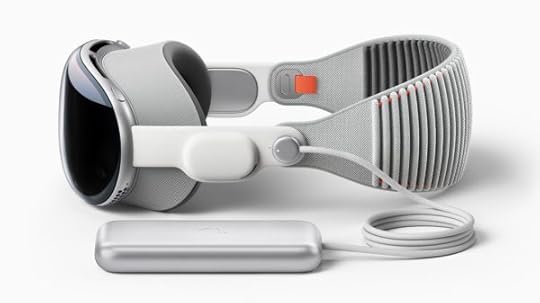
Apple Vision Pro (AVP)1 is heavy—a decent amount heavier (650 grams) than Meta’s Quest 3 (515 grams). It comes with a fancy band that goes on easily and you tighten with a little knob. It’s awesome. For 12 minutes. Then it started killing my face. With 3,500 regrets, I switched to the other band it comes with, which includes a loop that goes over the top of your head, and thank god for that because it was way better—so good that I am shocked to say that even at the end of a full day wearing it, I didn’t feel a euphoric “ahhh” relief taking it off. At least right now, it seems only a little more uncomfortable than wearing over-ear headphones for long periods of time. This might not apply to everyone, but I have not felt nauseous once while wearing it.
That doesn’t mean there’s nothing that sucks about wearing it. The “field of view” isn’t great, meaning there are thick black walls where your peripheral vision is supposed to be, which is a bummer. I can’t imagine it’s great for your eyes. And there’s no way around the fact that you feel like an asshole when other people are in the room.
There’s an external battery pack that connects to the headset with a cord and typically lives in my pocket. The battery lasts about three hours, but you can plug in the battery to make it last forever, like a computer if the battery only lasted for three hours. (You’re often using it in conjunction with your computer, which makes it a non-issue because you can plug the battery into the computer.)
When you put the headset on, it does the AVP version of Face ID: scanning your irises. This is seamless and very futuristic. Then, you see exactly what you saw before putting the headset on. Lots of reviewers have marveled over AVP’s “pass-through” capabilities, and the second I put it on, I understood why. While it’s not perfect, it’s almost like you’re wearing a transparent snorkeling mask. The headset is in fact opaque—cameras on the outside transmit the world onto screens on the inside. But the screens are so good and the latency so low that it really seems transparent. Then there’s the much less successful attempt to make it look transparent from the outside as well, using cameras on the inside to broadcast your eyes onto the front of the headset. The goal is that if you’re talking to someone while wearing the headset, it feels to both people like you’re wearing a transparent snorkeling mask. But at least in V1, the eyes don’t show up nearly as well as advertised.
The internal screens save energy by doing something clever called “foveated rendering”—i.e. only putting the exact place you’re looking in perfect focus while making the rest of the view lower-res. This is what your actual eyes do, which is why your peripheral vision is blurry. If you watch this viewcast I made, you’ll see that most of it is blurry (the sharp part was where I happened to be looking while taking it)—but as the person in the headset, I only ever saw perfect sharpness.
The way Vision Pro does audio is also cool. There have always been two sound options for me while on my phone or computer: play from the speaker and everyone can hear it or put on headphones and no one can hear it. AVP speakers are somewhere in between. The speakers (which sound great) are small and right above your ears, and while people right next to you can hear what you’re hearing, people in the next room cannot. So in a coffee shop or on an airplane, you still need headphones, but I do a lot of my work in an office in our house with the door open, and it’s been nice to work both without headphones and without bothering anyone in the other room.
Operating SystemThis was the biggest holy shit of my holy shit moment. Apple is the king of simple intuitive interfaces. Part of what drew those gasps in 2007 was how natural the iPhone’s interface was. You scrolled down by pushing the page up, just like you would in real life. You zoomed by pinching with two fingers. It seemed like magic. AVP’s interface is gaspworthy for the same reason. The main gesture is what I’ve been calling the “eye pinch.”
When you press the button at the top of the headset, your apps come up, floating in the room in front of you, looking as real as any other object in the room. They’re fixed in space. You can walk right up to them, and the detail is amazing.2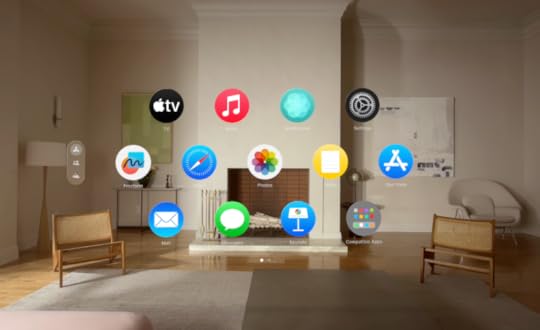
Vision Pro’s eye tracking is outrageously good. It knows precisely where you’re looking. So all you do to select an app is look at it and tap your thumb and index finger together. Your hand doesn’t need to move up to do this, just somewhere the headset can see it. Watching the ads, it seemed like this might be annoying to do, but it’s every bit as easy and intuitive as opening an app on a smartphone.
No matter what you’re doing, the eye pinch is the equivalent of touching a finger to a smartphone screen. To scroll, look anywhere in the window, pinch, and move your hand up. To move a window, look at the little bar below the window, pinch, and move it where you want to. To resize the window, look at the window’s corner, pinch, and resize.
As John Gruber put it in his review:
The fundamental interaction model in VisionOS feels like it will be copied by all future VR/AR headsets, in the same way that all desktop computers work like the Mac, and all phones and tablets now work like the iPhone. And when that happens, some will argue that of course they all work that way, because how else could they work? But personal computers didn’t have point-and-click GUIs before the Mac, and phones didn’t have “it’s all just a big touchscreen” interfaces before the iPhone. No other headset today has a “just look at a target, and tap your finger and thumb” interface today. I suspect in a few years they all will.
Then there’s the fact that everything you see in front of you is available desktop to work with. On my computer, I’m used to my applications being stacked, and I toggle between them. Or maybe I put a few vertical windows side by side. In AVP, I can put one eight-foot window in front of me, two more on either side of it, and a couple more above them in the sky. Then, if I get up to go to the other room, the windows all stay exactly where they are, waiting for me to come back. If I want to switch work spots, I just hold the headset button and the whole configuration jumps to the new location. This is all way cooler than I’m making it sound, so I made a video to show you how it works:
One thing you’ll notice in the video is that I routinely spin the digital crown on the headset to slide between being entirely in reality, partially in reality, and entirely in a virtual landscape. This is ridiculously fun to do. And it’s a general reminder that AR and VR2 being separate categories is a thing of the past. In the Vision Pro, the Quest 3, and any future headset, you can be 100% in the real world (when there’s nothing on the screen and it seems like you’re wearing a snorkeling mask), you can be mostly in the real world except there’s a virtual game board on your kitchen table or a little virtual butterfly fluttering around. You can be halfway between reality and virtual when, say, portals open up in the walls around you during a game. Or you can go full virtual.
AppsThere are many categories of spatial computing apps—productivity, entertainment, social, gaming, creative, fitness—and for most of them today, you’ll need a Meta Quest or some other non-Apple headset. There are a small handful of astounding apps for AVP, but they’re more a sampling of what’s possible than an actual app store.
The most “you can absolutely not do this anywhere but a VR headset” thing I did was their little taster menu of immersive entertainment. Entertainment on a headset runs on a spectrum of immersion. The least immersive is watching a normal movie on a massive screen in a virtual space like the moon or a giant theater. Those movies you missed that everyone says are best seen on the big screen—you can see those on a big screen now.
Next are movies that are framed in a normal rectangle, but they’re 3D looking—like when we used to wear those stupid paper glasses but much, much better. Sometimes, these surprise you when something comes out of the screen to fly through the air or stand on the floor between you and the screen. The AVR comes with one of these—“Encounter Dinosaurs”—and it’s delightful.
Finally, there’s full immersion, where the scene entirely surrounds you and you actually feel like you’re there. These are better described as “experiences” than “entertainment.” I saw rhinos up close in person last year. Then, this week, I did one of the Vision Pro experiences that’s an up-close hang with rhinos. These two experiences were very similar. Another experience lets you sit in on an Alicia Keys rehearsal where she sings some songs standing two feet away from you. You can watch her for a while, then look over at what the drummer or keyboardist is doing for a while—just like you would if you were actually there.
Photos and videos are also cool. When you take a panoramic photo, you sweep your phone around in a C-shaped arc—but on a flat phone screen, the result is a flat photo. In AVP, panos are C-shaped, like the photo you actually took. The C wraps around you, which I quickly learned brings the memory back way better than the flat version. You can also turn the headset into a camera and record photos and videos, both of which are immersive. When you later view them in the headset, they’re 3D, putting you right back into the actual scene.
Then there’s the infamous Vision Pro avatars. You get one of these by flipping the headset around and letting it take pictures of you from different angles. Then when you FaceTime someone, your avatar mimics whatever facial expressions you’re making. Here’s mine:

The first person I tested it out on was my wife, who immediately gasped in horror, saying I had “little uncanny valley snake eyes rolling around in my skull,” whatever the fuck that means.
The uncanny valley she’s upset about is this:3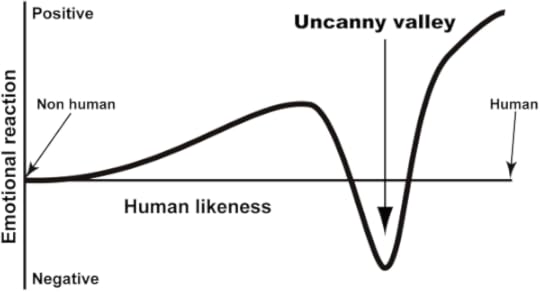
The idea is that we like faces that are somewhat humanlike, and we like faces that are totally humanlike, but we hate faces that are almost-but-not-totally humanlike. Faces that fall just short of being human give us the collective willies.
Avatars used to suck. Then they got better. Now they’ve gotten so good they’ve plunged into the uncanny valley. This was always gonna happen at some point on the road to perfect avatars and that time is now.
To test it out for myself, I FaceTimed my friend Jules Terpak, who also has a Vision Pro. First I put her across from me at this table while we sat around with each other’s uncanny valley faces for a few minutes.
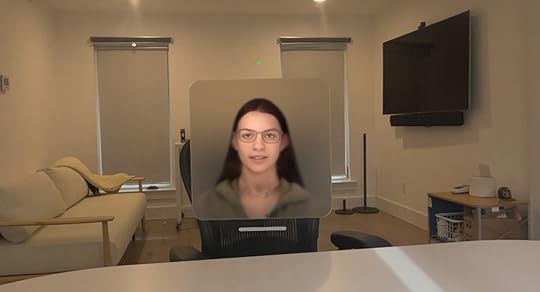
One very cool thing is that when I moved her window to a different seat at the table, her voice shifted locations to that spot. We concluded that this activity was not actually an upgrade over FaceTime, but that if there were more than two people, it could feel like everyone was sitting around a table together, which would be better than talking to a group FaceTime or Zoom.
Then we shifted locations to Mount Hood.

This felt more like we were actually hanging out somewhere, which is an effect you can’t get on FaceTime.
When we started going into apps together, it felt even more like we were actually doing an activity together, in a way you normally can’t do without being in person.

It’s very crude right now, but it’s a primitive version of something we’ll probably all be doing constantly in the 2030s. It’s the next step in a centuries-long human mission to conquer long-distance. First there were letters, then phone calls, then mobile phones3 and video calls. The next step is VR hangouts.
By far the thing I spent the most time doing in the Vision Pro was exactly what I normally do, but the AVP version. When you’re sitting down in front of your computer while wearing the headset, you can open your computer screen as a giant virtual window (which you still control with your normal keyboard and trackpad). Whatever screen you’re used to working on is now much, much bigger. It’s also much more mobile. I don’t usually work on the couch because I prefer my big monitor over my laptop screen. This week, I spent a lot of time working on my couch on a 100-inch monitor. I don’t normally work lying flat in bed because the laptop screen isn’t directly above me. This week I did, putting the screen up on the ceiling. I did some work outside on the porch and some more under a tree. Sometimes I saw the room around me, only with a big screen floating in it. Other times, I went fully immersive, writing on a mountain top, a sand dune, or the moon. And as I mentioned at the beginning of the post, I’m currently using the AVP in a coffee shop, which is officially embarrassing.
For some odd reason, you can’t open multiple desktops (yet), but you can open some of the things on your desktop as their own apps in separate windows. There’s an AVP iMessage app, so I closed iMessage on my desktop and opened it in an adjacent window. I often remotely cowork with Alicia (WBW’s Manager of Lots of Things), putting her in a little window in the corner of my screen. Now, she’s in her own window. If I’m willing to bite the bullet and switch from Chrome to Safari, I can pull my research and web browsing off the desktop too. The end result is that a single small, immobile computer screen has been replaced with a giant mosaic of screens, for the small price of having a snorkeling mask on my face all day. It kind of feels like you stepped into your computer screen, into the beautiful wallpaper landscape, amongst the windows. Very surreal. I wrote this entire post in the headset and have found myself enjoying writing more—and being more focused—than normal.
My overall feelingsThe best way I can describe how I feel about the Vision Pro is a strange combination of utterly thunderstruck and mildly underwhelmed.
The magical interface, the giant screens, the immersive experiences—they’re just unfathomably cool and awe-inspiring. It feels like a sneak peek at the 2030s.
But after a couple of days, I found myself thinking, “Is that…it?” I had done the small handful of immersive experiences, played some of the small selection of games, looked at a bunch of my panoramic photos, and tried avatar FaceTime—and at the moment, there’s just not that much else to do in the Vision Pro.
The first iPhone left me feeling the same combination of blown away and bored. The phone and I had a torrid honeymoon, but after the novelty of the interface wore off, all it had to offer was the same 16 practical apps.
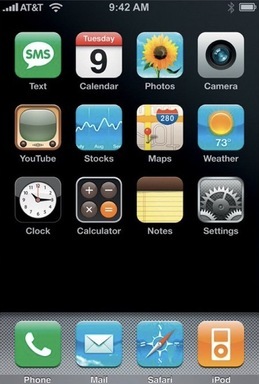
There was no app store yet, it dropped calls constantly, and the cellular internet (which you couldn’t use while on a call) was painfully slow. The iPhone wasn’t a world-changing device yet. It was the seed from which a world-changing device would grow.
If you zoom out on a story of technology, you usually see a big exponential curve.
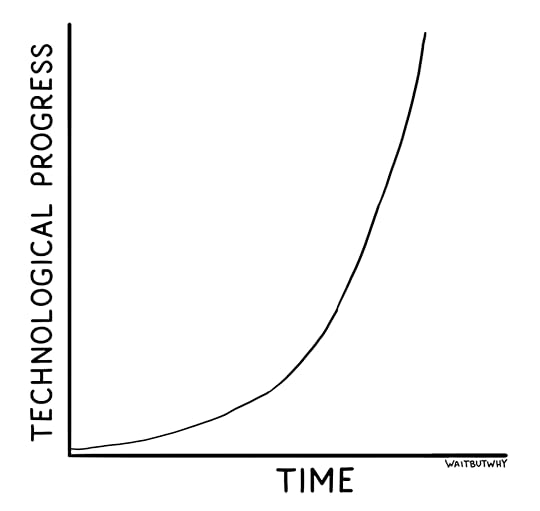
But if you look at the curve up close, you see that it’s wavy, made of S-curves.
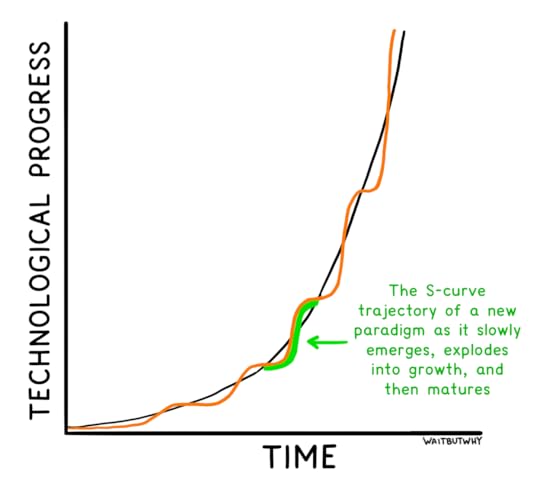
The first iPhone was such a big deal because it launched a new S. Investors had a new place to pour their money. Developers had a new place to pour their efforts. Creators had a new place to pour their talents. As millions of human hours worked on the collective human project, the next five years were a whirlwind of innovation and excitement. Apple’s keynotes became a must-watch for anyone interested in tech, as each jump between the iPhone 1 > 3G > 3GS > 4 > 4S > 5 was a major leap in hardware and software. It was the steep part of the S.

Then, the keynotes got boring. The changes were incremental. Apple stopped innovating and started refining. This coincided with Tim Cook taking over, but it isn’t his fault. The steep part of the S-curve doesn’t go on forever, and companies often reap the biggest rewards in the boring, top part of the S once the industry matures.
Maybe the reason VR has been slow to take off isn’t because there’s something fundamentally wrong with VR. Maybe it’s because, for the last decade, we’ve been working our way through the very early part of the VR S-curve—the slow part where foundational technology is researched and built. My Vision Pro is highly imperfect—overpriced, heavy, slightly glitchy, very limited, creepy-avatared—because that’s exactly what products are like at the bottom of the S. Consumer products aren’t ready for mass adoption during this stage. But it’s the breakthroughs made during these years that set the stage for the explosive exponential phase of the curve.
The lesson from past VR hype cycles is to temper expectations. The VR S-Curve explosion may be many years away or never come at all. But the lesson from past Apple launches is don’t bet against Apple, and Apple’s bet is that the Vision Pro could be a seed like the first iPhone—a platform for innovation that kicks a new S-curve into high gear.4
Vision Pro, V2 – V10For someone to regularly use a piece of technology, the benefits have to outweigh the costs. Right now, the Vision Pro benefits are probably less than the costs.

I’ve already paid for mine, which removes one of the costs, and it’s still a question to what extent I’ll choose it over my computer in the long run. In that regard, the AVP might currently be more like those first cell phones you had to carry around with a briefcase than the first iPhone. Would you get a cell phone if the only way they came was attached a briefcase? Maybe, but it’s a close call.
For VR to achieve mass adoption, the good needs to be better and the bad needs to be less bad. It’s easy to imagine a pathway to both.
The operating system will get better each year. The two-finger pinch is currently the only gesture. More will be added. Eventually, there may be dozens of ways to make gestures with our fingers, each one a different command, like today’s keyboard shortcuts. When you spend ten minutes setting up an elaborate configuration of windows, you’ll be able to save (and share) it.
Avatars will go from uncanny valley to indistinguishable from your normal face. When you go into immersive environments, you can currently see only your hands. In the future, you’ll be able to identify other objects to remain visible (like a coffee mug). The environments around you will expand from the six current options to hundreds, including delightful fantasy worlds, and they’ll be interactive, allowing you to change things like the weather.
The hardware will get continually smaller and more comfortable. The resolution and frame rate will become as advanced as the latency. The battery will get way better. So will the look from the outside: to people in the room, the headset will come to look totally transparent. (My personal fantasy: The computer itself becomes detachable, allowing the headset to be a light, sleek, cool-looking visor. The computer and battery snap together into something the size of a smartphone. You’ll be able to snap it to the back of your visor if you don’t want the cord, but most people will prefer the weight to be somewhere other than their heads. The computer/battery rectangle will also have a screen and function as a smartphone for times when you want to do something with the visor off. The visor will fold neatly onto the rectangle to make the whole thing a single compact object.)
Finally, the amount of content, applications, and experiences will multiply by 1,000-fold, just like the apps in the app store did from 2008 to today. There will be a wide array of immersive games and entertainment. People will watch sports from one of many vantage points on the field, sideline, stands, or overhead—next to their friends, who will be able to look at each other and talk as well as if they were actually together in person. Pop stars will play in front of 50,000 people in person and 5 million people virtually. Fitness will become fun, interactive, and social. The best teachers and coaches will reach millions of people. Amazing AI teachers could reach billions. Distance will melt away, allowing people to spend high-quality time with their loved ones, no matter where they are. People who couldn’t dream of traveling the world today will get to enjoy vivid experiences anywhere on the globe. Of course, my silly 2024 imagination can’t scratch the surface any more than people in the briefcase phone days could have predicted Uber, TikTok, or Tinder.
Over time, the price will come down, with some companies making headsets dirt cheap the way they have for smartphones today. As the value proposition gets better and better, more people will have them, enhancing the social component and eradicating any stigma. Mass adoption seems like a very real future possibility.
I know what many of you are thinking: A world where everyone is in VR headsets (or visors, or glasses, or contact lenses) sounds dystopian and awful. And granted, this is coming from a guy who thought that world of glazed over people in moving chairs in Wall-E looked like a great place to live—but I’m excited.
K can I take this thing off my face now?
_______
What to read next:
A post about a technology even more intense than VR
A post about a different technology that’s also even more intense than VR
A post about a third technology that’s even more intense than VR
_______
If you like Wait But Why, sign up for our email list and we’ll send you new posts when they come out.
To support Wait But Why, visit our Patreon page.
When you use the Quest 2 in a new setting, you have to manually show the headset the boundaries of the open space you’re going to be using. This isn’t needed in the more recent Quest 3, which automatically maps out the space.↩
“Virtual Reality” has traditionally referred to totally immersive headset experiences. “Augmented Reality” is when you see the real world around you with virtual elements added in.↩
We’re so used to mobile phones that we forget how insanely cool they are. I can pick up my rectangle and instantly contact you wherever you are on the planet.↩
If this is what happens, unboxed first-generation Vision Pros will be auctioned for a ton of money in 2060. Just saying…↩
The post All My Thoughts After 40 Hours in the Vision Pro appeared first on Wait But Why.
May 23, 2023
10 Thoughts from the Fourth Trimester
Back in February, I wrote a post about my upcoming book that included a big visual of the timeline. Just two weeks after the book launch, my first baby would be born. I’d promote the book, catch my breath, and then begin the new adventure.
Thank god for those critical two weeks.
The night before book launch was (obviously) a frantic all-nighter, and I eventually went to bed after 40 hours awake, exhausted and satisfied. We had done it. The book was live. It was over. I’d actually wake up tomorrow without this project hanging over my head. The sky would be blue. I’d finally be free.
I woke up close to noon and felt at peace for three seconds before opening my phone and seeing three texts from my wife:
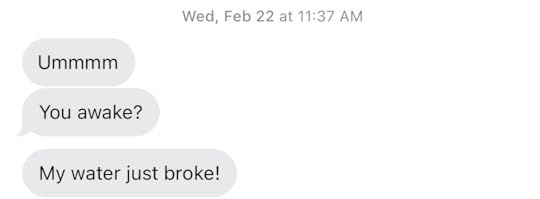
Hm?
I knew what water breaking was. But I didn’t know what it meant. Is the baby coming out now? Or was this one of the false alarms I had heard about and the baby is still a couple weeks away? Is there a chance she just peed her pants and is misdiagnosing the situation?
After some rapid-fire googling, one thing was clear: We had to go to the hospital. Now.
The drive was weird. I had pictured myself heroically driving a screaming labor-having wife to the hospital, but here I was driving normally to the hospital with a very normal wife next to me. Apart from her new leaking situation, nothing was different than it was yesterday. There was no way we were actually having a baby today. Right?
Upon arrival, the PA assessed things and yes her water had broken, and yes in order to avoid infection that meant the baby had to come out now. Two hours and 12 canceled book-promoting podcasts later, we’re in our delivery room, where my still-not-in-labor wife would supposedly be producing a baby sometime later today.
Again, there was a major expectations-reality gap. I had pictured the day of my first child’s birth being impossibly frenetic and emotional and intense. But there we were, eating animal crackers and gummies from the treats-you-can-eat-while-in-labor bag, hanging out and chatting like any other day.
My wife was hooked up to a bunch of tubes and machines and the plan was to see if contractions would start on their own as a reaction to her water breaking, but a few hours passed and nothing happened. Eventually, the nurse came in and poured a magical little chemical called Pitocin into her IV bag.
And things started happening.
Contractions began, which my wife described as “a really bad period cramp,” which helped me understand what they felt like 0%. Over the next couple hours they got worse and worse. I was quickly assigned the role of “don’t say or do anything” while contractions were happening, so I’d just kind of sit there awkwardly and watch with this face on:

Her epidural plan was something like “definitely get one but tough it out a little first,” and after a particularly awful contraction, she called it a day and the epidural team came in to do their thing. 45 minutes later, we’re back in the “I know this is the day of the birth of our first child but it sure doesn’t feel like it” zone, chatting and hanging out normally. After a few more hours, a nurse came in and checked on the dilation situation and was like “alright, let’s do this!”
Once again, nothing like I pictured. I thought there would be a big team of doctors and nurses doing a whole big hectic thing and I’d be standing somewhere on the side. Instead, it was me and this nurse, each holding a leg.

The game went like this: When a contraction starts, we each grab a leg and she pushes really hard for 10 seconds three times in a row. Then everyone chills and hangs out for a few minutes until the next contraction. And repeat.
After a few rounds of this, it was clear this was not gonna work. Nothing was coming out. But we kept trying anyway.
And then I saw it.
The edge of an upsetting slimy pancake.

When I asked what the upsetting slimy pancake edge was, the nurse told me it was my daughter.
Uh huh.
This then went on for a while. We’d do a round of pushing, the upsetting pancake thing would come out a centimeter and then go back in, and each round it would come out a few more millimeters. It was increasingly feeling like we really weren’t getting anywhere with this strategy when the nurse suddenly says “okay let’s deliver a baby!”
She makes a call and a few minutes later a group of people come in, including the first doctor we had seen that day. The next contraction came along, I leg-held, my wife pushed, and then in the most surreal moment of my life, I was staring at a tiny screaming alien.
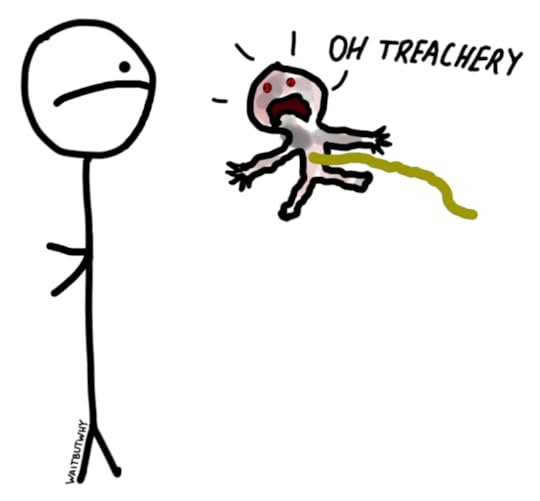
___________
That was 3 months ago. I’ve had a lot of thoughts since then. Here are 10 of them:
1) A newborn is not a babyI thought it was gonna be like this:

But it’s actually like this:
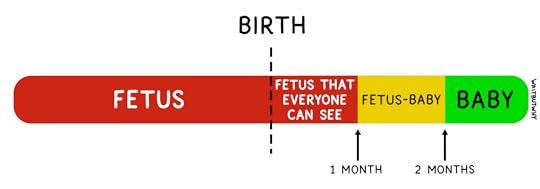
A newborn is not a baby. Babies are cute and roly-poly and can see and are conscious and are normal and a newborn is not any of these things. It is a bizarre human larva that acts super weird and would still be in the womb if it could be. The problem is, when humans went bipedal, our pelvises got smaller, and as humans got smarter, our heads got bigger. So evolution had to get creative. Its solution: all human babies would be premies, born when they were still small enough to pass through a human pelvis. The last couple months as a fetus would happen outside the womb, and everyone would just have to deal with that. This became incredibly obvious during the first month with my daughter. She was a raw human id not remotely ready for primetime. Thankfully, since then, a baby has grown around the id and now she has the figure of a miniature 390-pound 84-year-old woman.1
2) It is insane that there’s not some required training for new-parents-to-beIf I want to drive a car, I have to take driver’s ed first. If I want to provide medical advice, I have to go to med school first. But after we had the baby, the hospital was like “don’t shake it k bye.”
I know a lot of words I didn’t used to know. Meconium. Tummy time. Latching. Bicycling. Swaddle. Colostrum. I know how many ounces of milk and hours of sleep the baby is supposed to have each day. I know baby CPR and the baby Heimlich maneuver. I know how to induce baby burps and shits. I know how warmly to dress a baby. I know what temperature baby bathwater should be. I know what sleep training is and when it’s okay to start it. I know that you can’t just pick a newborn up, you have to pick all the pieces up at the same time or else the pieces fall off.

But I only know all of these things because I read books and articles and am fortunate to have people I can call with questions. And society’s current plan is to just expect/hope that every new parent does the same?? There should obviously be like a mandatory four-hour course every expecting parent has to take before they’re actually in charge of a newborn.
Instead, people like to say things like “you’ll figure it out” and “just use your instincts.” You could apply the same logic to driving and people probably would just figure it out—but we don’t do it that way, because that would be absurd.
3) Babies have giant heads*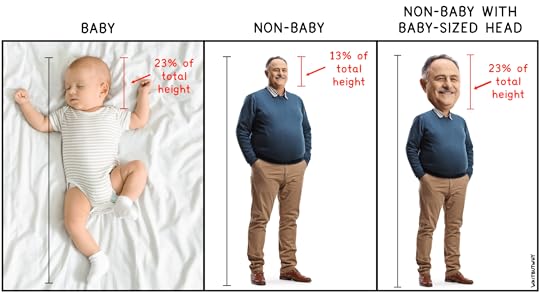
*I made this visual thinking it was gonna emphasize how big baby heads are, but after looking at the big-headed guy on the right for a while, it started to look normal to me, and the normal-headed guy suddenly looked like he had a ridiculously small head. So now I’m realizing that the big takeaway is that baby heads are normal and the rest of our heads are tiny.
4) Babies are incredibly overdramaticWhen a normal person is hungry, or tired, or needs to burp, they’re a little annoyed. Babies are in Shakespearean agony. And then comes the burp and one second later they’re like “sup.” It’s insane behavior.
For a while, the range of baby emotion runs from Shakespearean agony to neutral, never entering the positive realm. Neutral is a newborn’s best-case scenario.
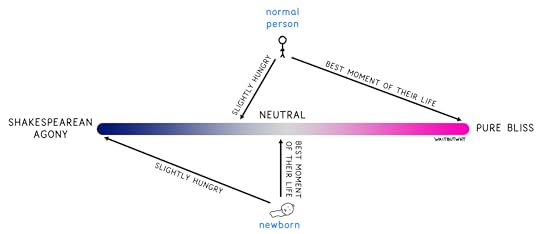
After six weeks or so, positive emotion begins to make an appearance, but then they still go apoplectic at the slightest inconvenience.2
While we’re here, I know it’s bad but I can’t help it—crying babies are funny. My wife completely disagrees with me on this.
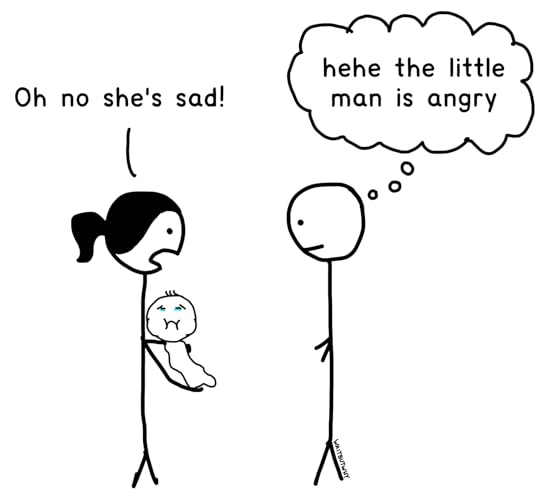 5) The parent-newborn relationship is super one-sided
5) The parent-newborn relationship is super one-sided

It’s weird—you have all of these intense feelings for this little person* and there’s just nothing to do with those feelings. I could squish her face, but then she’d cry and I’d be abusing a baby. In the early weeks, there’s just not really a satisfying outlet for your baby fondness and it’s annoying.
One other one-sided thing is you’re apparently supposed to talk to your newborn even though they’re an unconscious fetus because it supposedly helps develop their brain. So now my baby has heard multiple versions of my next book outline, the full story of the rise and fall of the Assyrian Empire after I listened to a podcast about it, and a list of every World Series champion going back to 1990. Never once has the baby shown any sign of being affected by any of this.
*That said, I’ve always thought of parental love as the most intense form of love—the kind where if you had a Sophie’s choice where your baby and spouse were both hanging off a cliff and you could only save one, you’d save the baby without a second thought. And…yeah I’m not there yet. I love this little creature a freakish amount, but as of now, I’m definitely saving my wife in that situation. Sorry kiddo. I’m sure Tim the Baby-Saver-Wife-Dropper will at some point emerge, but I guess it takes some time.
6) Babies shit all over your scheduleObvious one, I know, but just check this out:1
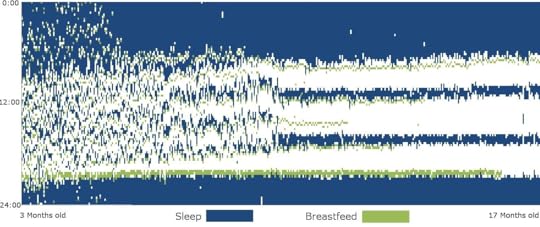

These are the sleep graphs of three different babies, but they all have one thing in common: there’s no rhyme or reason in the early months, because newborns are dicks.
7) It’s mathematically impossible to know if your baby is cute or notI think my baby is impossibly adorable, of course, but every parent thinks that about their baby, so that offers no information. Everyone who has met her or seen a picture of her has commented on how cute she is, but they’d say that no matter what she looked like—which I know as someone who has commented on the cuteness of babies ranging from perfect to hideous—so there’s no information there either. FYI, I once depicted what happens when friends visit someone with an uncute baby:

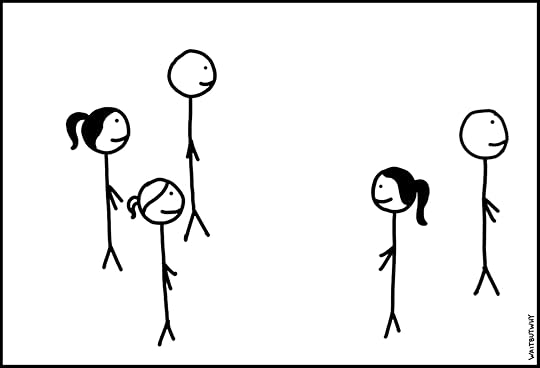

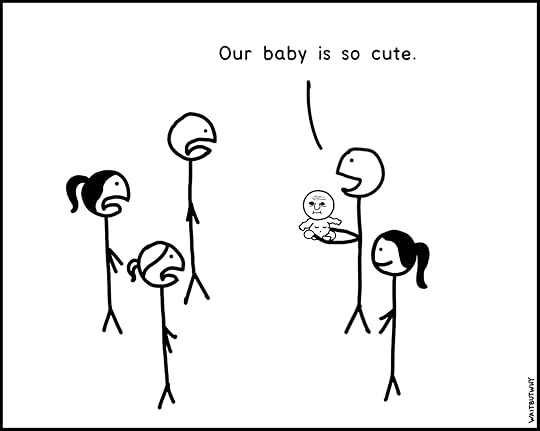
 8) I’m a motor skills virtuoso
8) I’m a motor skills virtuosoIt’s pretty amazing how bad babies are at everything. They’re terrible at thinking, at knowing anything, at moving all parts of their body. The cool thing is that spending time with a super unimpressive baby has made me super impressed by myself. Like I’ll watch the baby sitting in a baby bouncer trying to reach for a little wooden flower one foot in front of her and she just flings her arm in the general direction and misses by a lot. Then I’ll reach for a glass of water and all of my joints work together to send my hand on a perfectly straight path through three-dimensional space, gracefully clasp my fingers around it using the perfect amount of pressure, raise it to my mouth, tilt it in perfect sync with the movement of my lips, and then return the glass to the table and gently place it down like an absolute genius.
9) You don’t go from a non-parent to a parent overnightSome things are just too big for our little human brains to fully absorb. The bigness of the universe. The permanence of death. The magnitude of the marriage decision, which I once described like this:
When you choose a life partner, you’re choosing a lot of things, including your parenting partner and someone who will deeply influence your children, your eating companion for about 20,000 meals, your travel companion for about 100 vacations, your primary leisure time and retirement friend, your career therapist, and someone whose day you’ll hear about 18,000 times. Intense shit.
A few months into fatherhood, this feels like another item in that category. When your baby is born, you will (hopefully) never live another day as a non-parent. For people who make the decision to do this, it is the BC-AD line of their life. It doesn’t mean you can’t still be you, but you are trading in one kind of life for another, with all of the pros and cons that come along with it.
I don’t think I’ve been able to quite wrap my head around the bigness of the situation. A curious childless friend asked me the other day if I feel like a dad, and I surprised myself by answering “not really.” I mostly feel like old me that has this new delightful little thing living in my house. When I see friends with sentient kids actually parenting them, saying things like “that’s not nice, stop it,” whatever that must be like is as much of a mystery to me as it was three months ago. For me at least, it seems like a parent is something you slowly turn into as your first baby slowly turns into a person.
Btw I’m now even more convinced than I was before that this is the most personal of personal decisions and no one should ever try to pressure anyone else to have kids—it’s way too big a thing to be anyone else’s business.
10) Having a baby really makes you think about the futureEvery parent in history has brought their baby into a world with an uncertain future. But our future is the uncertainest. My baby might live a life a lot like mine, just a little more futuristic. Or she might live to 500. She might live most of her life with a brain-machine interface implanted in her head, thinking with her own superintelligent AI. She might suffer through civilizational collapse. She might live in a world that would seem like utopia to us today. She might live on Mars. She might meet aliens. She might die in the apocalypse. There’s just no way to know. It makes all of those fun, exciting, terrifying conversations about the future hit just a little harder.
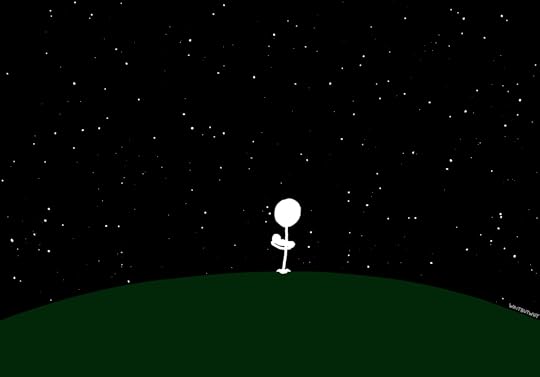
_______
If you like Wait But Why, sign up for our email list and we’ll send you new posts when they come out.
To support Wait But Why, visit our Patreon page.
_______
More thoughts with comics:
10 Types of Odd Friendships You’re Probably Part Of
The Great Perils of Social Interaction
11 Awkward Things About Email
If you can’t decide whether to marry your significant other: The Marriage Decision: Everything Forever or Nothing Ever Again
If you’re hearing everyone talk about AI and would like an overview: The AI Revolution: The Road to Superintelligence
One thing I kept thinking during the first few weeks: it’s really weird that Einstein and Hitler and Shaq and Plato and Queen Elizabeth were all wiggly, flailing little aliens at one point.↩
Speaking of which, companies that make onesies that snap instead of zipper should be sent to the gulag.↩
Sources: Graph 1, Graph 2, Graph 3↩
The post 10 Thoughts from the Fourth Trimester appeared first on Wait But Why.
10 Thoughts From the Fourth Trimester
Back in February, I wrote a post about my upcoming book that included a big visual of the timeline. Just two weeks after the book launch, my first baby would be born. I’d promote the book, catch my breath, and then begin the new adventure.
Thank god for those critical two weeks.
The night before book launch was (obviously) a frantic all-nighter, and I eventually went to bed after 40 hours awake, exhausted and satisfied. We had done it. The book was live. It was over. I’d actually wake up tomorrow without this project hanging over my head. The sky would be blue. I’d finally be free.
I woke up close to noon and felt at peace for three seconds before opening my phone and seeing three texts from my wife:

Hm?
I knew what water breaking was. But I didn’t know what it meant. Is the baby coming out now? Or was this one of the false alarms I had heard about and the baby is still a couple weeks away? Is there a chance she just peed her pants and is misdiagnosing the situation?
After some rapid-fire googling, one thing was clear: We had to go to the hospital. Now.
The drive was weird. I had pictured myself heroically driving a screaming labor-having wife to the hospital, but here I was driving normally to the hospital with a very normal wife next to me. Apart from her new leaking situation, nothing was different than it was yesterday. There was no way we were actually having a baby today. Right?
Upon arrival, the PA assessed things and yes her water had broken, and yes in order to avoid infection that meant the baby had to come out now. Two hours and 12 canceled book-promoting podcasts later, we’re in our delivery room, where my still-not-in-labor wife would supposedly be producing a baby sometime later today.
Again, there was a major expectations-reality gap. I had pictured the day of my first child’s birth being impossibly frenetic and emotional and intense. But there we were, eating animal crackers and gummies from the treats-you-can-eat-while-in-labor bag, hanging out and chatting like any other day.
My wife was hooked up to a bunch of tubes and machines and the plan was to see if contractions would start on their own as a reaction to her water breaking, but a few hours passed and nothing happened. Eventually, the nurse came in and poured a magical little chemical called Pitocin into her IV bag.
And things started happening.
Contractions began, which my wife described as “a really bad period cramp,” which helped me understand what they felt like 0%. Over the next couple hours they got worse and worse. I was quickly assigned the role of “don’t say or do anything” while contractions were happening, so I’d just kind of sit there awkwardly and watch with this face on:

Her epidural plan was something like “definitely get one but tough it out a little first,” and after a particularly awful contraction, she called it a day and the epidural team came in to do their thing. 45 minutes later, we’re back in the “I know this is the day of the birth of our first child but it sure doesn’t feel like it” zone, chatting and hanging out normally. After a few more hours, a nurse came in and checked on the dilation situation and was like “alright, let’s do this!”
Once again, nothing like I pictured. I thought there would be a big team of doctors and nurses doing a whole big hectic thing and I’d be standing somewhere on the side. Instead, it was me and this nurse, each holding a leg.

The game went like this: When a contraction starts, we each grab a leg and she pushes really hard for 10 seconds three times in a row. Then everyone chills and hangs out for a few minutes until the next contraction. And repeat.
After a few rounds of this, it was clear this was not gonna work. Nothing was coming out. But we kept trying anyway.
And then I saw it.
The edge of an upsetting slimy pancake.

When I asked what the upsetting slimy pancake edge was, the nurse told me it was my daughter.
Uh huh.
This then went on for a while. We’d do a round of pushing, the upsetting pancake thing would come out a centimeter and then go back in, and each round it would come out a few more millimeters. It was increasingly feeling like we really weren’t getting anywhere with this strategy when the nurse suddenly says “okay let’s deliver a baby!”
She makes a call and a few minutes later a group of people come in, including the first doctor we had seen that day. The next contraction came along, I leg-held, my wife pushed, and then in the most surreal moment of my life, I was staring at a tiny screaming alien.
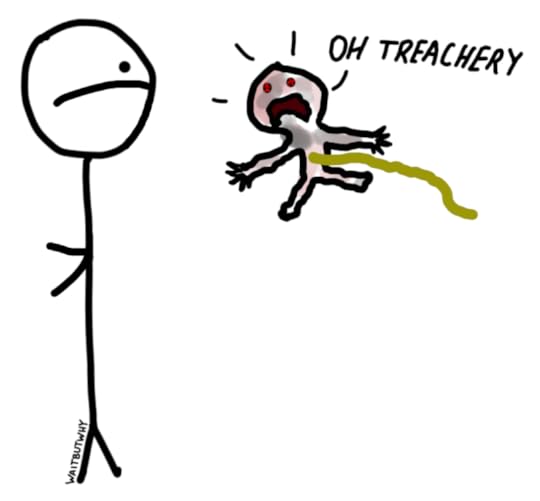
___________
That was 3 months ago. I’ve had a lot of thoughts since then. Here are 10 of them:
1) A newborn is not a babyI thought it was gonna be like this:

But it’s actually like this:

A newborn is not a baby. Babies are cute and roly-poly and can see and are conscious and are normal and a newborn is not any of these things. It is a bizarre human larva that acts super weird and would still be in the womb if it could be. The problem is, when humans went bipedal, our pelvises got smaller, and as humans got smarter, our heads got bigger. So evolution had to get creative. Its solution: all human babies would be premies, born when they were still small enough to pass through a human pelvis. The last couple months as a fetus would happen outside the womb, and everyone would just have to deal with that. This became incredibly obvious during the first month with my daughter. She was a raw human id not remotely ready for primetime. Thankfully, since then, a baby has grown around the id and now she has the figure of a miniature 390-pound 84-year-old woman.1
2) It is insane that there’s not some required training for new-parents-to-beIf I want to drive a car, I have to take driver’s ed first. If I want to provide medical advice, I have to go to med school first. But after we had the baby, the hospital was like “don’t shake it k bye.”
I know a lot of words I didn’t used to know. Meconium. Tummy time. Latching. Bicycling. Swaddle. Colostrum. I know how many ounces of milk and hours of sleep the baby is supposed to have each day. I know baby CPR and the baby Heimlich maneuver. I know how to induce baby burps and shits. I know how warmly to dress a baby. I know what temperature baby bathwater should be. I know what sleep training is and when it’s okay to start it. I know that you can’t just pick a newborn up, you have to pick all the pieces up at the same time or else the pieces fall off.
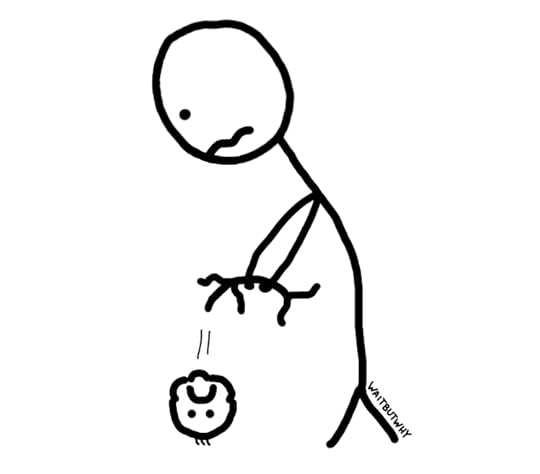
But I only know all of these things because I read books and articles and am fortunate to have people I can call with questions. And society’s current plan is to just expect/hope that every new parent does the same?? There should obviously be like a mandatory four-hour course every expecting parent has to take before they’re actually in charge of a newborn.
Instead, people like to say things like “you’ll figure it out” and “just use your instincts.” You could apply the same logic to driving and people probably would just figure it out—but we don’t do it that way, because that would be absurd.
3) Babies have giant heads*
*I made this visual thinking it was gonna emphasize how big baby heads are, but after looking at the big-headed guy on the right for a while, it started to look normal to me, and the normal-headed guy suddenly looked like he had a ridiculously small head. So now I’m realizing that the big takeaway is that baby heads are normal and the rest of our heads are tiny.
4) Babies are incredibly overdramaticWhen a normal person is hungry, or tired, or needs to burp, they’re a little annoyed. Babies are in Shakespearean agony. And then comes the burp and one second later they’re like “sup.” It’s insane behavior.
For a while, the range of baby emotion runs from Shakespearean agony to neutral, never entering the positive realm. Neutral is a newborn’s best-case scenario.

After six weeks or so, positive emotion begins to make an appearance, but then they still go apoplectic at the slightest inconvenience.2
While we’re here, I know it’s bad but I can’t help it—crying babies are funny. My wife completely disagrees with me on this.
 5) The parent-newborn relationship is super one-sided
5) The parent-newborn relationship is super one-sided

It’s weird—you have all of these intense feelings for this little person* and there’s just nothing to do with those feelings. I could squish her face, but then she’d cry and I’d be abusing a baby. In the early weeks, there’s just not really a satisfying outlet for your baby fondness and it’s annoying.
One other one-sided thing is you’re apparently supposed to talk to your newborn even though they’re an unconscious fetus because it supposedly helps develop their brain. So now my baby has heard multiple versions of my next book outline, the full story of the rise and fall of the Assyrian Empire after I listened to a podcast about it, and a list of every World Series champion going back to 1990. Never once has the baby shown any sign of being affected by any of this.
*That said, I’ve always thought of parental love as the most intense form of love—the kind where if you had a Sophie’s choice where your baby and spouse were both hanging off a cliff and you could only save one, you’d save the baby without a second thought. And…yeah I’m not there yet. I love this little creature a freakish amount, but as of now, I’m definitely saving my wife in that situation. Sorry kiddo. I’m sure Tim the Baby-Saver-Wife-Dropper will at some point emerge, but I guess it takes some time.
6) Babies shit all over your scheduleObvious one, I know, but just check this out:1
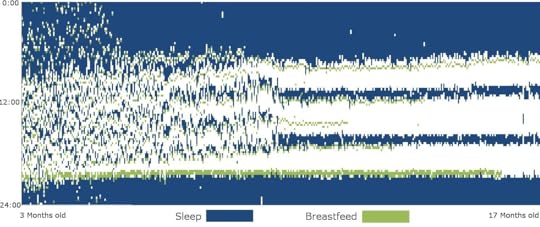

These are the sleep graphs of three different babies, but they all have one thing in common: there’s no rhyme or reason in the early months, because newborns are dicks.
7) It’s mathematically impossible to know if your baby is cute or notI think my baby is impossibly adorable, of course, but every parent thinks that about their baby, so that offers no information. Everyone who has met her or seen a picture of her has commented on how cute she is, but they’d say that no matter what she looked like—which I know as someone who has commented on the cuteness of babies ranging from perfect to hideous—so there’s no information there either. FYI, I once depicted what happens when friends visit someone with an uncute baby:
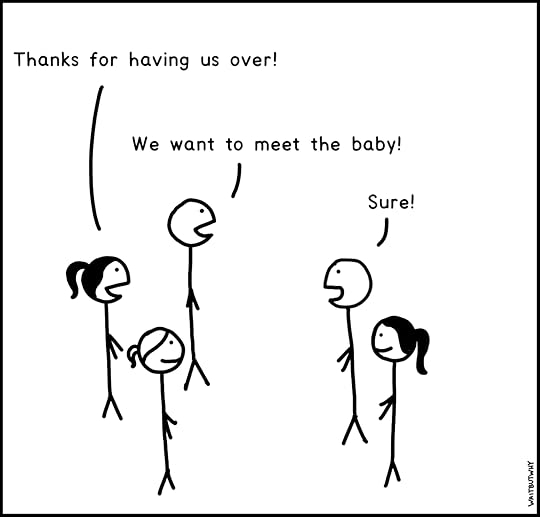



 8) I’m a motor skills virtuoso
8) I’m a motor skills virtuosoIt’s pretty amazing how bad babies are at everything. They’re terrible at thinking, at knowing anything, at moving all parts of their body. The cool thing is that spending time with a super unimpressive baby has made me super impressed by myself. Like I’ll watch the baby sitting in a baby bouncer trying to reach for a little wooden flower one foot in front of her and she just flings her arm in the general direction and misses by a lot. Then I’ll reach for a glass of water and all of my joints work together to send my hand on a perfectly straight path through three-dimensional space, gracefully clasp my fingers around it using the perfect amount of pressure, raise it to my mouth, tilt it in perfect sync with the movement of my lips, and then return the glass to the table and gently place it down like an absolute genius.
9) You don’t go from a non-parent to a parent overnightSome things are just too big for our little human brains to fully absorb. The bigness of the universe. The permanence of death. The magnitude of the marriage decision, which I once described like this:
When you choose a life partner, you’re choosing a lot of things, including your parenting partner and someone who will deeply influence your children, your eating companion for about 20,000 meals, your travel companion for about 100 vacations, your primary leisure time and retirement friend, your career therapist, and someone whose day you’ll hear about 18,000 times. Intense shit.
A few months into fatherhood, this feels like another item in that category. When your baby is born, you will (hopefully) never live another day as a non-parent. For people who make the decision to do this, it is the BC-AD line of their life. It doesn’t mean you can’t still be you, but you are trading in one kind of life for another, with all of the pros and cons that come along with it.
I don’t think I’ve been able to quite wrap my head around the bigness of the situation. A curious childless friend asked me the other day if I feel like a dad, and I surprised myself by answering “not really.” I mostly feel like old me that has this new delightful little thing living in my house. When I see friends with sentient kids actually parenting them, saying things like “that’s not nice, stop it,” whatever that must be like is as much of a mystery to me as it was three months ago. For me at least, it seems like a parent is something you slowly turn into as your first baby slowly turns into a person.
Btw I’m now even more convinced than I was before that this is the most personal of personal decisions and no one should ever try to pressure anyone else to have kids—it’s way too big a thing to be anyone else’s business.
10) Having a baby really makes you think about the futureEvery parent in history has brought their baby into a world with an uncertain future. But our future is the uncertainest. My baby might live a life a lot like mine, just a little more futuristic. Or she might live to 500. She might live most of her life with a brain-machine interface implanted in her head, thinking with her own superintelligent AI. She might suffer through civilizational collapse. She might live in a world that would seem like utopia to us today. She might live on Mars. She might meet aliens. She might die in the apocalypse. There’s just no way to know. It makes all of those fun, exciting, terrifying conversations about the future hit just a little harder.
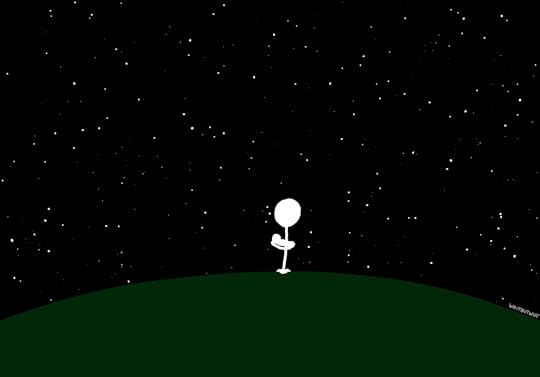
_______
If you like Wait But Why, sign up for our email list and we’ll send you new posts when they come out.
To support Wait But Why, visit our Patreon page.
_______
More thoughts with comics:
10 Types of Odd Friendships You’re Probably Part Of
The Great Perils of Social Interaction
11 Awkward Things About Email
If you can’t decide whether to marry your significant other: The Marriage Decision: Everything Forever or Nothing Ever Again
If you’re hearing everyone talk about AI and would like an overview: The AI Revolution: The Road to Superintelligence
One thing I kept thinking during the first few weeks: it’s really weird that Einstein and Hitler and Shaq and Plato and Queen Elizabeth were all wiggly, flailing little aliens at one point.↩
Speaking of which, companies that make onesies that snap instead of zipper should be sent to the gulag.↩
Sources: Graph 1, Graph 2, Graph 3↩
The post 10 Thoughts From the Fourth Trimester appeared first on Wait But Why.
February 17, 2023
A Short History of My Last Six Years
June 18, 2016. Obama was president, the Cavs were on their way to beating the Warriors in the NBA finals, Game of Thrones was still good, and I was 34 years old with my whole life ahead of me.
Wait But Why had been around for three years, a stretch during which I wrote about 100 blog posts on dozens of topics. On the afternoon of June 18, 2016, I was sitting on the couch engaging in a familiar ritual: looking through my list of future post ideas, trying to pick my next topic. And then I had a thought.
So many of the post ideas I was scanning through were about the future. Virtual reality. Artificial intelligence. Genetic engineering. Life extension. Multiplanetary expansion. But lately, it felt like there was a cloud hanging over all these topics.
My urge to write about the future comes from an excited optimism that’s fundamental to my personality. I believe at a deep level that the future is going to be an amazing, exhilarating ride, and nothing is more fun than learning about cutting edge developments that can offer clues into what magic might lie down the road.
But on June 18, 2016, I didn’t feel excitedly optimistic. There was a different feel to the world than there had been in my previous blogging years. Something seemed off about the society around me, like there had been a subtle, foreboding shift in the balance between reason and madness. It felt like we were losing our grip on something important.
The fun thing about being a blogger is you can write about whatever the fuck you want. And a good compass for me had always been that if something was incessantly on my mind, it was probably a good post topic. So I decided to write what I call a “mini post.”
Wait But Why articles are long, and they go deep. I bathe in the topic for a little while, dread writing it for a little while, then finally pump it out, draw the drawings, give it a read, and post. A mini-post is much chiller—I just open WordPress and type what’s on my mind, and post it.
So I opened WordPress to write a little post about that cloud I felt hovering over my other post topics. I’d knock out a draft tonight, give it a read tomorrow, and publish it.
But nothing came out. I didn’t know where to start.
There were a bunch of bad trends: Tribalism was flaring up everywhere, mass shaming campaigns were roaring back into fashion, politicians were increasingly clown-like, public discourse had become a battle of one-dimensional narratives. But why was all of this happening now? Was the problem related to social media? To politics or current events? Was it some broader cultural or psychological phenomenon?
I also noticed that I wasn’t feeling the normal confidence I felt when I started a new post. Something about this topic felt scary. I never felt scared to write about anything before. This fear of writing about this topic seemed like it was an important part of the topic.
Nope. Not a mini-post. I needed the full week for this one.
But a funny thing happened that week. I didn’t write anything. Instead, I started jotting down notes and ideas in a Text Edit document called “society” that quickly became long and messy. I abandoned that document and opened up “society 2” to give myself a fresh start. Soon there was a Society folder with seven note documents.
I could have just stopped there. Too big a topic, too out of my wheelhouse, too icky, too scary. An outline for a virtual reality post was sitting right there in my Future Posts folder waiting for me.
But I’m really, really bad with the sunk cost fallacy. I had already put so much time and thought in, and I couldn’t handle all of it being for nothing.
And so began the next six years of my life.
I wish I could say that I actively decided to put everything else aside and write a giant opus on the problems with my society. But it didn’t happen like that. If you asked me at any point over the past six years when I was gonna be done with my society post—and plenty of people did—the answer was always, “I’m finally getting close.” And I believed it every time. I fully believed, every time, that this thing was almost done. The delusion of a madman.
And the problem with this particular delusion is that it’s a perfect way to ruin your life. If I believed I was working on a six-year project, I’d have worked the project into my normal life. I’d get into a rhythm that would allow for a work-life balance. But when you think you’re at most a couple months from finishing a big project, it makes sense to put everything else on hold for just a little bit more until the project is done. I wasn’t someone who never made fun plans or who worked on every vacation or who took a lot of Vyvanse—I was someone who did those things just for right now, because I’m in crunch time on a big project. For six years.
In May of 2017, I asked my girlfriend to marry me. We had been dating since 2011. She had seen the whole Wait But Why journey up close and had now been living with “I’m almost done with this big project” Tim for a year. We set our wedding date for October of 2018. Thank god by then I’d be out of this pit and working on all kinds of other fun projects.
But instead of the project wrapping up, it just got bigger.
The topic had led me down dozens of totally different rabbit holes, and everything I read seemed relevant to it. I don’t like telling a partial story. Like I had in other posts, I was determined to tell the full, full story. If I noticed something in my reading or on social media or in the news that seemed like an important piece of the puzzle, it had to be incorporated. If that fucked up the current outline, then the outline would have to adapt.
The problem is that the outlines became ridiculous. I couldn’t keep it all in my head at once, so I made sub-outlines, and sub-sub-outlines. The Society folder now looked like this:
As 2017 became 2018, I decided that the wedding would be the hard deadline that I needed. My girlfriend had spent way too much time with an “I’m almost done with this massive post on society” boyfriend. She would have a much more pleasant husband.
 I’m still not sure how I turned into a crazy person. The way to proceed was obvious. I should pick a piece of this albatross, throw the rest away, and focus in on it. Do what I had done for years—suck it up, get serious, knock something out, and move on with my life.
I’m still not sure how I turned into a crazy person. The way to proceed was obvious. I should pick a piece of this albatross, throw the rest away, and focus in on it. Do what I had done for years—suck it up, get serious, knock something out, and move on with my life.
But I’m a nightmare of a perfectionist and knew that the ultimate prize was to figure out how to not focus in but capture it all in a single, overarching story. It all was one big story, and I wanted to tell it.
Wedding day came and went.
People in my life were worried about me. They tried encouraging me, shaming me, setting deadlines for me, reminding me that one post really shouldn’t take multiple years. Nothing seemed to help.
Finally, in mid-2019, I hatched a plan that would once and for all end this thing. Rather than post a gargantuan blog post, I’d make it a series. This would break it into parts, which is less daunting. Plus, I had learned that the adrenaline of knowing that my readers were only days away from seeing what I was working on was a huge motivator that I had been sorely missing.
I called it The Story of Us and in August of 2019, the first chapter went up. The whole thing would be 12 chapters, I decided, and even though the chapters got longer as they went, and the time between them expanded, it was finally happening—I was publishing the damn thing. The end was near.
Then came Chapter 11. The first 10 chapters had introduced the core framework of the series and talked broadly about the big picture of what I thought our problem was. In Chapter 11, I was going to dip into more controversial territory, looking at the past few years of news stories through the lens of the framework we had developed.
It turns out I had a lot more to say about what was going on around me than I had anticipated. Soon, my draft of Chapter 11 was longer than the first ten chapters combined. I have problems.
Now it was the middle of 2020. Covid was in full swing. Thousands of people were marching by my apartment in protest. It was a seismic year for American society. Everything I was writing about was happening, and rapidly evolving, literally outside my window. What I had written months earlier suddenly seemed stale. Also, Chapter 11 was over 100,000 words. Death.
It started to dawn on me that I really needed to just turn this into a book. Between the mountains of feedback I had gotten from readers and friends on The Story of Us and the mountains of new thoughts I had about all the recent developments in the world, I knew that there was one way to really bring the project from hell home: open a blank Microsoft Word document and write a newer, better, complete story, and do it in a book format that people could read more easily than a web page. Somewhere, a fairy died.
So I started writing the book. I’d call it the name it should have always been called: What’s Our Problem? I knew what I wanted to say. I just had to write it.
I finished V1 in December of 2021 and triumphantly tweeted about it.
Done! In a sense! It was 250,000 words, which is about 150,000 words too long. And missing most of the drawings. And I had a giant “ADD IN” document full of news stories which had happened in the year and a half since I started writing the book that would need to be incorporated.
It’s hard to cut writing. Perfectionism, sunk costs, etc. Procrastination abound. I would try to cut a section down, polish it off, and move on, but kept finding myself rewriting the section entirely. I was moving at a snail’s pace.
Then one day in June of 2022, my wife woke me up by handing me a positive pregnancy stick. It was a surreal, joyful moment. I’ve never been anyone’s dad before but always wanted to be. Then the thought hit me.
NOPE. 100% no. It could not happen. This baby could not enter a world where this project was still going on. Suddenly, an old friend entered the room.
The baby was due on March 7, 2023, so this book would be completely done by mid-February, period end of story.
V2 got finished (July 2022). Then V3 (September). Then V4 (December). Editors and fact-checkers and copy editors and ebook designers and audiobook engineers were hired. Alicia (Wait But Why’s Manager of Lots of Things, who had already put in thousands of hours helping with every element of the process), went into crazy crunch time mode. I sat in a booth for 45 hours reading the audiobook (January). The ebook was designed (February). The launch date was set.
It took 2,440 days, but my mini-post on society is done and coming out on Tuesday. Fuckin shit.
Here are the pages:
Some stats:
121,000 words303 drawings11,081 documents in my Society folderI’m 41A condensed and re-written Story of Us makes up 25% of the book. The rest is all new.This book is my best crack at explaining what I think is an existential risk to liberal societies and what I think we need to do to get to that awesome future I used to be so excited about. There are dozens of concepts in the book that serve as a kind of toolbox for understanding our societies, our group dynamics, and our own minds. I’m very proud of the final product and never want to have an experience like this again.
If you would like to take my last six years and put it into your brain, here are the different options (all available on Tuesday Feb 21):
Ebook: Available on most major platforms (you can also buy the EPUB directly). It looks best on color e-readers and tablets (especially on vertical scroll mode), but also fine on phones and black-and-white e-readers. The best ebook experience we’ve seen is Apple Books > iPad > sepia > vertical scroll. Available for preorder on Apple and Kindle – the rest are available on launch day, Feb 21.
Wait But Why: Without the limitations of the other formats, this is where the drawings can be displayed full-size, where footnotes can be interactive, etc. The downside here is that you can only read it on a tablet or phone, not an e-reader, and there’s no dark mode at the moment (we’re working on that for later in 2023). Available here.
Click here to see how the book looks in different formatsAudiobook: Available on most major platforms (or you can buy the mp3 directly). Read painstakingly by me. I personally do most of my reading via audiobook, so I tried to make it the best possible experience. The obvious downside is that the book has 300+ visuals, so we made a webpage (and pdf) for audiobook listeners with the 46 most important drawings, numbered. When I get to that point in the reading, I say something like, “Go look at drawing number 24.” Available for preorder on Kobo and on other platforms (Audible, Apple, Spotify, and more) on launch day.
If you can’t afford it: I really want everyone who wants to read this book to be able to do so, so if you can’t afford to buy the book, email us at whatsourproblem@waitbutwhy.com and we’ll give you a code that lets you read it on WBW for free.
Print: There is not a print version, which I know will disappoint some people. There are a few reasons for this, but the biggest one is that printing this big full-color book would have delayed launch by many, many months, and fuck that.
Also, Idea Labs: A major theme in this book is how we can do better at having productive discussions about tough topics. So we’re planning to create virtual book clubs for anyone who is interested in discussing the book with other WBW readers. More on this soon, but if you’re interested in being part of a book club, enter your email address here.
So that’s the story with this book. Can’t wait to hear your thoughts. If you want to be notified on launch day and keep up with whatever else we work on in the future, make sure you’re on our email list.
___________
Another time I did something hard: Doing a TED Talk: The Full Story
The number of years this book took me: From 1,000,000 to Graham’s Number
If the news is making you scared about A) UFOs or B) AI
If you’d like to support Wait But Why, here’s our Patreon.
The post A Short History of My Last Six Years appeared first on Wait But Why.
April 27, 2021
Why Going to the Doctor Sucks
Disclaimer: This is a post about going to the doctor in America, why it sucks, and a way to make it better. It’s also a post about my wife’s startup. Which means I’m almost certainly biased on this topic. But also I really think these things. I wouldn’t say things on WBW if I didn’t really think them, because that would be a dick thing to do. But I’m also not exactly a neutral observer on this one. But still. K? K.
___________
There’s someone I’d like you to meet.
This my wife, Tandice. We met back in 2011.
It took a while but I eventually won her over, and we’ve been together ever since.
No problem.
Anyway, one of the things about Tandice is that she’s kind of Larry-David-esque, and she likes to complain about stuff.
Her most impassioned complaints are reserved for one particular type of experience: the doctor’s office.
Tandice has a rare autoimmune disease that, without some very novel treatments, would cause her immune system to attack her eyes and destroy her vision. This, plus some general hypochondria, has made her somewhat of a regular at the doctor’s office.
The frustrations start with making the appointment.
Then comes the actual appointment.
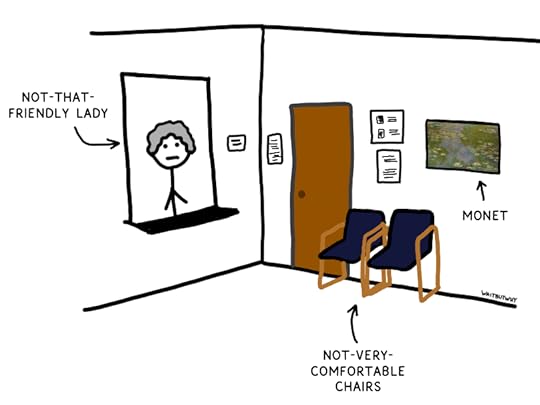

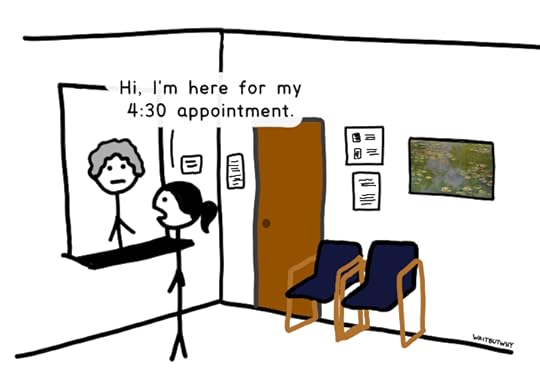
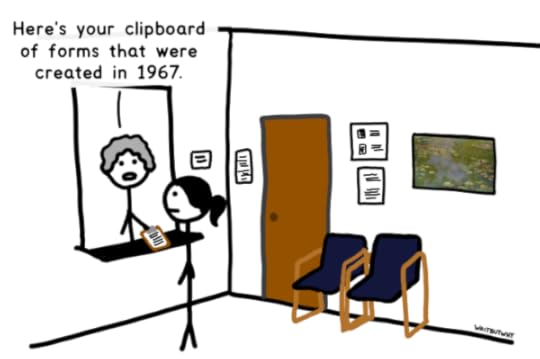
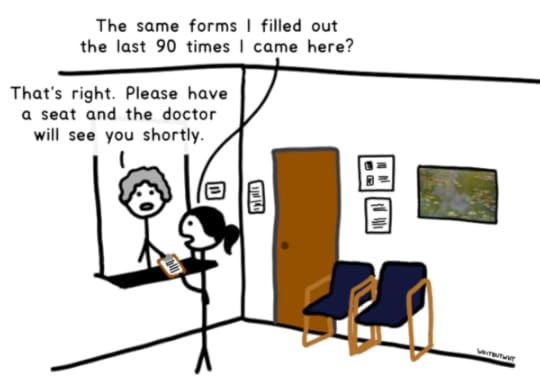

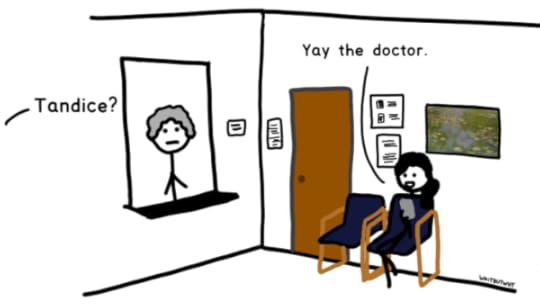


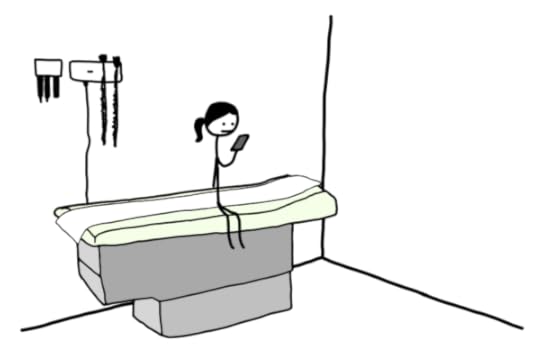
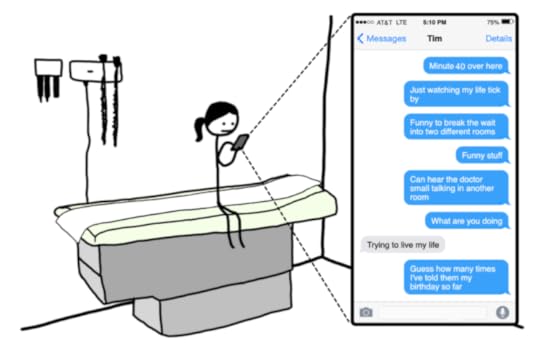


Over the years, Tandice’s complaints have turned into curiosity. Why, in 2021, in the U.S., would going to the doctor be so shitty?
Why going to the doctor sucksSo you know how the free market looks kind of like this?
Well the U.S. healthcare industry looks more like this:1
What the hell?
It definitely isn’t a single-payer system—but as investor Bill Gurley explains, it’s not a free market system either:
There is no price evaluation during the purchase. The person paying is not the person consuming the service, and the majority of choices are made without comparative options. In many ways, we have the worst of both worlds. Our system … has the illusion of a free market and the illusion of regulated market with the apparent benefit of neither. 1
Car insurance makes sense, because a car accident can happen to anyone, anytime, and the resulting damages and liability could leave the driver on the hook for tens or even hundreds of thousands of dollars, something very few people can afford. The same logic applies to catastrophic coverage in health. For bearing the cost of an unexpected ambulance, injury, cancer treatment, etc., insurance is a good system.
But if the auto industry were like the healthcare industry, your employer2 would be incentivized to swap out some of your salary with auto coverage of their choice. When it was time for an oil change, you’d have to look for “in-network” auto shops. I’m glad that’s not how the auto industry works.
I’m not sure what exactly I think the U.S. healthcare system should look like—but I’m pretty sure it shouldn’t look like this. Maybe one day the system will change, but rather than hold our breath for that, let’s talk about one aspect of the system we can do something about: going to the doctor.
The beauty of a basic free market interaction—at, say, a local barber—is that the business and customer incentives are entirely aligned. To get more of what it wants (revenue), the barbershop needs loyal customers—something that only happens when people have a good experience at the shop and leave with a haircut they like, at a price they think is reasonable.
But the convoluted U.S. healthcare system screws up that alignment. Sure, doctors get paid when patients choose to use their services, but there are two middlemen who distort that relationship, as a majority of the doctor’s actual payment comes from the insurer (who also negotiates the prices), and the insurer gets a majority of its payments from the employer.3 The patient is so far removed from the doctor, financially, that the various prices for the doctor’s services aren’t even available to the patient—they’re treated more like proprietary back-office info that’s none of the patient’s business. While there’s still some element of consumer choice and competition, the typical patient’s limited in-network options and the lack of transparency when comparing those options significantly dilutes this powerful motivator. Mostly, the system’s fee-for-service model incentivizes doctors to see a high volume of patients, even if it comes at the expense of quality.
American patients aren’t treated like customers because they’re not customers. Once you consider this, the typical4 American patient’s experience makes much more sense. The wait time for an appointment (24 days on average in the U.S.) and the inconvenient open hours. The lack of basic modern conveniences (I make my haircut appointments online but have to call the doctor’s office and listen to hold music). The stereotypically long waits on the day of the appointment (often because many doctors book two patients for every time slot). The lack of any follow-up after an appointment or any sophisticated way for patients to access their history and analyze trends.5
All of this feels a whole lot like the experience we have at places like the DMV or the post office—places where there’s little practical incentive to provide good customer service. It’s also probably why so many Americans put a doctor’s visit into the same bucket as a trip to the DMV or the post office: something to avoid if at all possible.
In a world where every decade raises our expectations for ease and convenience, it’s no surprise that people, especially young people,6 are going to the doctor less and less.
Count me among them. My last doctor’s appointment—a typical experience that was unpleasant and mostly unhelpful—was four years ago. I’ve since replaced the doctor with four things:
1) Ignoring my health and hoping for the best
2) Asking Google questions
3) Asking my doctor friends questions
4) Visiting urgent care clinics7
This is obviously not a great plan. Whether you’re a “me” kind of patient or a Tandice kind of patient, or somewhere in between, there’s a good chance you’re not getting what you need from the healthcare system.
And it was just as Tandice was starting to wonder if she might be able to do something about all this that she met Chloe.
They were introduced through a mutual friend who thought they might have a lot to talk about. Chloe was a breast cancer survivor who, after having to navigate the system at such a young age, from treatment to specialist coordination to post-survivorship care, was also fixated on the problem of being a patient. They got together to discuss.
Tandice came home electrified. She and Chloe were going to build the doctor’s office they wished they could go to. They decided to call it The Lanby.
The LanbyTandice and Chloe spent the next six months researching, brainstorming, planning, white boarding, flow charting, spreadsheeting, and generally organizing their list of patient complaints.
The first question they had to answer was, “Is there some good reason healthcare has to suck like this? There’s gotta be some reason it’s like this, right?” The answer turned out to be, “Actually, not really.”
The second question was, “Where do we start?” They knew they couldn’t overhaul the whole system, so they decided to focus on their own experience and what they wish they had most during their patient journeys: one centralized healthcare home base. This, they believed, should be the role of primary care.
From there, the natural third question: “What could great primary care look like if it were designed purely from the patient’s perspective? What would be our dream experience as a patient?”
Reasoning from first principles, they started to lay down what they believed should be the core features of great primary care:
Easy. Friction should be minimized at every step of the way.
Unlimited. A primary care physician isn’t just another specialist. Primary care should be both the patient’s first line of defense and their long-term partner. The exact kind of thing that’s best as a flat-fee, unlimited-use model—something patients are incentivized to interact with as often as they want to or need to.
Financially simple. A single annual membership fee and that’s it. No middlemen or extra costs. Likewise on the doctor’s side: a flat, annual salary that, unlike the fee-for-service model, incentivizes quality over volume.
Comprehensive. True primary care should focus on all facets of a patient’s health, not just medical health.
Continuous. To facilitate a long-term partnership, patients should be seen by the same practitioners every visit. Continuity should also extend to specialist referrals. Primary care should be the patient’s hub, making the referral, communicating with the specialist, and closing the loop after the treatment.
Common sense-y. When in doubt, go with common sense. Example: Some patients prefer to exclusively see the doctor in person. Some would like to go entirely virtual. But common sense suggests that most would like a mix, depending on the reason for the visit.
Patient-centric. Every single decision should be run through the “what would this be like for the patient?” lens.
With those as the building blocks, they designed something they believed could nail every important point: a primary care member’s club.
The basic framework: Members pay $2,400/year ($2,000 right now, more on that below) and have unlimited visits, both in person and virtually. It’s a no-insurance model, though members should still carry basic insurance (to cover catastrophic care, specialist visits, labwork, and prescriptions). This keeps insurance confined to the places where insurance makes sense and lets patients be actual customers where that makes sense.8
Tandice and Chloe imagined themselves joining this kind of members club, and brainstormed what it would have to be like to absolutely delight them. They concluded that there were really two realms to great primary care: the care itself, and everything about the patient experience surrounding that care (“delivery”). Here’s their plan for each:
1) CareThinking about primary care from first principles yielded an interesting insight: primary care should ideally be handled by three practitioners, not just a single doctor. If The Lanby was really going to live up to its promise and cover every aspect of a patient’s basic health, each member should be assigned to a three-person team that worked together to provide comprehensive, continuous, and coordinated care. Here’s how it looks:
The doctor is the kind they wish they had: Someone curious, patient, and empathetic. Someone with a wide breadth of knowledge and lifelong learner who’s always up on the latest research.
The wellness advisor takes on everything about your health that’s outside of the doctor’s direct purview: nutrition, exercise, sleep, etc. Is Whole 30 the right kind of diet for me? Do air purifiers actually do anything? Is a Fitbit the best health tracker? The wellness advisor’s got you.
The concierge manager is a registered nurse and your go-to contact—someone you can text anytime about anything health-related. Basically how you’d treat your parent if they happened to be a medical professional.
A Lanby member can know that somewhere out there, a group of pros is obsessed with their health and has it covered—in both a short- and long-term sense.
2) DeliveryDelivery is the hidden beast at the heart of good (or awful) healthcare. If we imagine the consumer experience as a spectrum, The Lanby’s goal is to take healthcare delivery from Point A to Point C.
Going from A to B is simple: treat the patient like a customer and bring the systems from the 1960s into the 2020s. At Point B, appointments are easy to make, for sometime soon, and they actually last long enough for all the patient’s questions. Patient data is collected and easy to access online, where patients can also order refills and chat with the team. Point B means making everything in the Tandice-at-the-doctor comic good/easy/modern/effective instead of bad/hard/archaic/useless. An analysis of 35,000 online reviews revealed that 96% of patient complaints are about customer service. Getting to Point B should take care of that.
Going from Point B to Point C takes things to the next level with a new concept: healthcare hospitality.
Healthcare hospitality means that everything is nice. The space looks great and smells great and the seats are super comfortable. When you walk in, you’re offered a cup of coffee. There’s a bookshelf full of health-related books you can check out, old school library-style. There will never be a clipboard of forms because handing a customer a clipboard is the opposite of hospitality. Cozy robes instead of paper gowns. Charmin instead of industrial one-ply toilet paper. The Aesop soap Tandice is obsessed with instead of pink gas station soap. Marginal costs for the business that do wonders for the patient experience.
On a deeper level, healthcare hospitality means that Lanby members get the distinct feeling that The Lanby gives an immense shit about them. It starts with the basics: reviewing patient charts before the appointment starts, making real eye contact during patient visits, and never asking a patient to repeat the same information twice. And then it’s about going the extra mile: If a member texts them after hours, they’ll probably respond anyway. If they know a member is interested in a particular new fitness movement, they’ll send the member an interesting article about it when they see it. They’ll host classes and events in the office to make The Lanby a fun community.
If all of this sounds a little over the top for a doctor’s office, we should consider whether maybe all of our expectations are in the wrong place for something as important as our health. Tandice and Chloe are convinced that American healthcare has a “tragedy of low expectations” problem. We’re outraged if a restaurant makes us wait for a meal, but not if the doctor makes us wait for our healthcare? We’re outraged if the person at a hotel front desk is unfriendly to us—but we shrug and take a seat when that happens at the doctor’s office? It makes no sense.
Which gets to the bigger point:
The big pictureThe American healthcare system is full of problems. But our health also suffers from a human nature problem.
Humans tend to be highly irrational about long-term planning, no matter how important it is. Prioritizing our health seems frivolous when we’re healthy.
This kind of thinking makes The Lanby seem like a luxury service—because $2,400/year is luxurious when spent on something frivolous. But healthcare when you’re healthy is anything but frivolous. It’s critical preventive care—the kind that prolongs (and often saves9) our lives and drastically increases our chance of a happy future (and which ends up saving us money over the long run).
If humans were perfectly rational creatures, we’d all be highly attentive to our health and put the proper effort toward preventive care. But since we’re not, one fix is to hack the human system by sweetening the experience enough that our dumb short-term brains actually like going to the doctor.
If going to the doctor is an easy, lovely experience, we’ll go more often. When there’s an expert who always wants to talk to you about your diet, sleep, and exercise, we’ll live a healthier lifestyle. When it’s incredibly easy to send a text to ask a quick health question, we’ll ask more health questions. When preventive care is a way of life, we’ll have a healthier future.
Tandice and Chloe are excited to run their dream doctor’s office—but they’re most excited about the burgeoning paradigm shift The Lanby could be a part of. A future industry could include lots of iterations on this model, at lots of different price points (some have already sprung up). Their long-term vision is to set a whole new standard for primary care. And once we get used to that new standard, I’m pretty sure the old model will look utterly archaic—and really bad for you.
Founding MembershipsThe Lanby is launching in September 2021, starting with 300 “Founding Members”.
They think of Founding Members the way they’d think of a friend who offered to be an advisor—as part of their extended team. Founding Members can meet with the founders, offer early feedback, and help The Lanby be a service for patients, by patients. Ideal Founding Members are people who think a lot about health and would like to have a voice in the future of healthcare.
Brainstorming how they could give back to those critical first members, Tandice and Chloe settled on a lifelong discount. Founding Members will pay only $2,000/year (instead of $2,400/year) for life. When they move into a bigger space, the membership fee will likely go up, but advisory members stay at $2,000/year. When they open multiple locations and offer a higher-priced “all clubs” membership tier, advisory members are in that tier for the same $2,000/year. You get the point. And of course, the team plans to go above and beyond to make sure they have an extra special experience.
Founding Members, and only Founding Members, will also be given the opportunity to invest in the company and sit on an Advisory Member Board. By launching using only membership fees and member investor funds, The Lanby can ensure all incentives remain entirely patient-focused.
If you want to be a Founding Member, sign up here (available to the first 300 people who join). Members can be located anywhere in the U.S., as long as they can make it to Manhattan at least once a year for an in-person visit.
If you have questions about anything I’ve written or anything about the company, text Tandice at (301) 541-8386.
I’m also doing a Clubhouse session with Tandice and Chloe this Wednesday at 8pm ET.
More Lanby Stuff:Their Instagram
An article Chloe wrote about care
An article Tandice wrote about delivery
—————
If you like Wait But Why, sign up for our unannoying-I-promise email list and we’ll send you new posts when they come out.
To support Wait But Why, visit our Patreon page.
For my daily musings, follow WBW on Twitter and Instagram.
—————
Wait But Why on a totally different kind of healthcare
The funny thing is this is the significantly simplified version. When you include the government, hospitals, the pharmaceutical industry, etc. it’s even more of a mess.↩
About half of all Americans receive health insurance through their employer. This strange custom is a remnant of the Stabilization Act of 1942, which froze wages and salaries for all the country’s workers. Looking for new ways to attract workers during the wartime labor shortage, employers started offering better health insurance, a loophole that was allowed to increase over time by “a reasonable amount.”↩
This is such a mess for consumers that there’s an entire industry—patient advocacy—devoted to helping people navigate the insurance system and its many codes and methods for getting refunds on unfair charges.↩
There are exceptions for each of these, but this is a reasonable representation of the system as a whole.↩
Tools do exist, but they tend to be such a nightmare to use that patients don’t use them.↩
A recent poll by the Kaiser Family Foundation found that 45% of 18–29-year-olds no longer have a primary care provider at all.↩
Urgent care clinics are increasingly popular because of their convenience and because they, more than the typical traditional doctor’s office, actually treat patients like customers. They’re conveniently located, take walk-in appointments, and often list their prices. But there’s no continuity—each visit is with a new doctor who knows nothing about you or your health history, and they have a tendency to over-prescribe quick fixes like antibiotics, often when it’s not the correct treatment.↩
Doing an experiment outside the traditional insurance model means it inevitably won’t be accessible to everyone. One thing that does help offset the cost, though, is that by front-loading healthcare spend on primary care, patients can also consider going for a higher deductible, lower monthly payment plan. And there’s the effect on long-term costs (one study found that having a PCP ultimately saves patients 33% on health care costs overall). The membership fee can also be paid using HSA/FSA dollars.↩
According to the CDC, “up to 40% of annual deaths from each of five leading U.S. causes are preventable.”↩
The post Why Going to the Doctor Sucks appeared first on Wait But Why.
September 30, 2020
The Trump-Biden Debate
In case you missed it, here’s a transcript of the first Trump-Biden Debate:
Chris Wallace: Good evening. I’m Chris Wallace and I welcome you to what I predict will be a very bad personal experience for me. There will be six 15-minute segments, each on a different topic. At the beginning of each segment, both candidates will get two uninterrupted minutes to respond. The remainder of the segment will be open discussion. The audience has agreed not to be trashy. Both campaigns have signed off on these rules, so for sure nothing will go wrong. And with that, let’s welcome the candidates.
[CANDIDATES ENTER]
Wallace: Let’s start with the Supreme Court. President Trump, you nominated Amy Coney Barrett to succeed the late Ruth Bader Ginsburg on the court. You say the Constitution is clear about your obligation to nominate someone to the court. Vice President Biden, you’ve called this an abuse of power. To start, why don’t you both explain your positions.
Trump: Amy Coney Barrett is a perfect nominee. Conservatives love her. Liberals love her. Chris Wallace loves her.
Biden: Amy Barrett would repeal the Affordable Care Act. And besides, the new thing is that you have to wait until after the election to nominate someone.
Trump: Not sure what you’re talking about, because last I checked a presidential term is four years, not three. You want to instate Communist medicine.
Biden: I don’t want to instate Communist medicine. I want to expand Obamacare.
Trump: Your party wants to instate Communist medicine, and you’re scared of them.
Biden: I may be scared of them but I am the Democrat Party now, so even if I was and still am scared of them, I’m not anymore. They’ll do what I say now. And how about Covid? The president killed 200,000 people. Roe v. Wade.
Trump: You would have killed 2 million people by not banning China. Not Roe v. Wade.
Wallace: K let’s go back to healthcare for a minute. Mr. President, over the past four years you have promised to replace and repeal Obamacare, but you have never in these four years come up—
Trump: Yes I have.
Wallace: with a plan—
Trump: Of course I have.
Wallace: to—
Trump: Of course I have.
Wallace: replace—
Trump: I got rid of the individual mandate.
Wallace: Oba—
Trump: The individual mandate was a joke.
Wallace: macare.
Trump: The individual mandate was the worst part of Obamacare.
Wallace: I am the moder—
Trump: The individual mandate sucks dick.
Wallace: I AM THE MODERATOR of this debate and I would like to be treated as such. You have never come up with a plan to replace Obamacare. So what is the Trump healthcare plan?
Trump: I’m cutting drug prices. Insulin is like water.
Wallace: Uh huh. How about you Joe? Why do you want to end private insurance?
Biden: I don’t want to end private insurance.
Trump: You’re literally friends with Bernie Sanders.
Biden: No I’m not. I want to—
Trump: You’re a piece of shit Joe.
Biden: I want to make sure—
Trump: A sad little man.
Wallace: Stop picking on Joe, Mr. President.
Trump: You care deeply about Bernie Sanders. You like Communist medicine. Anyway I asked the doctors and they said Obamacare is a disaster.
Biden: He doesn’t have a plan.
Wallace: Changing gears, Joe some of your colleagues are talking about ending the filibuster and packing the court. What’s your stance on that?
Biden: My stance is that voting is good. Americans should vote. It’s easy. You just go to the polling place, you wait in line, and then you go into the booth, and you push the little switch down for the candidate you want to vote for. Sometimes it’s not a switch.
Trump: You gonna pack the court, Joe? Tell us about how you’re gonna pack the court, Joe. The radical Left is pulling your puppet strings Joe. You and I both know it Joe.
Biden: Shut up, man.
Wallace: This is going well. Okay next segment. Covid-19. There have been more than 7 million cases in the United States and more than 200,000 have died. The question is, why should people trust you more than your opponent to handle this public health crisis?
Biden: 40,000 people a day contracting Covid. 200,000 people dead. He has no plan. He knew in February. He lied. He panicked. He complimented China. He has no plan. He’s playing golf.
Trump: I saved lives. It’s China’s fault. You wanted to let Chinese people come here. Dr. Fauci and all the Democrat governors said, “President Trump did a phenomenal job.” And they’re not the only ones. All of the other people said it too. “President Trump did a phenomenal job,” they all said. I did a phenomenal job. The gowns, the masks, the ventilators, you don’t know how to make a ventilator, the vaccine is here, any week now. You could never have done the job I did because you’re a random old man. You couldn’t even do swine flu. Swine flu is a disaster.
Biden: He panicked. People died. And more people are gonna die unless he gets a lot smarter—
Trump: Did you just use the word smart? You lied about going to college at Delaware State. You were the worst student at Delaware State. You’re a dumb fuck Joe. I know it. Chris Wallace knows it don’t you Chris.
Wallace:
Trump:
Biden:
Wallace: Mr. President, you have begun to increasingly question the effectiveness of masks. Are you not in favor of masks?
Trump: Masks are tremendous. I have a mask right here in my pocket. I wear masks when needed. Masks have said I’ve done a phenomenal job. Joe wears masks even when it makes no sense. He wears them when he’s 200 feet away from me. He wears a mask when he’s sleeping.
Wallace: Mr. Vice President, is that true?
Biden: If you wanna open a business, you gotta have a plan.
Wallace: Sir, I was asking about masks.
Biden: Oh masks? Sure, you gotta have a mask.
Wallace: Alright next segment. The economy. Mr. Trump, you go first.
Trump: It’s a big dick economy.
Biden: No.
Wallace: Okay how about taxes. Mr. President, apparently you pay $750 a year in taxes. There’s a girl my daughter knows who’s 15 and she works in a movie theater on Sundays and sells the candy. And she pays more than $750 a year in taxes. So is this true, Mr. President? How much did you pay in taxes in 2016 and 2017?
Trump: Miyyons.
Wallace: Miyyons, sir?
Trump: Miyyons and Biyyons. I don’t pay taxes because the Obama administration said I didn’t have to.
Wallace: Joe, what’s your plan for taxes?
Biden: I’m gonna build this economy. I’m gonna make jobs. We’re gonna buy American. We’re gonna buy American ships. American steel. American buildings. We handed him a booming economy and he blew it.
Wallace: But did you actually hand him a booming economy and did he actually blow it?
Biden: Sure, whatever. He talks about the art of the deal. China has perfected the art of the steal.
Trump: China buttered your son’s belly.
Biden: China did no such thing.
Trump: And then, Joe? You know what happened after that? Your son went to Moscow. And you know what happened there Joe? Moscow buttered your son’s belly.
Biden: Nothing happened there.
Trump: Sure did Joe. The mayor of Moscow’s wife. She buttered his belly slick.
Biden: You wanna talk about families Trump? How about your family. With their grease and their shoes. It’s not about families. It’s about the American people. It’s about families.
Trump: Oh and how about Ukraine?
Wallace: You know what? Time to move on to—
Trump: Ukraine buttered the shit out of—
Wallace: Mr. President.
Trump: Ukraine buttered him up real good.
Wallace: Mr. President.
Trump: Shut your mouth Chris. What about Ukraine Joe?
Wallace: VAAAAAAAAAAAAHHHHH
Trump:
Wallace: Now I’m gonna say something and I want you to listen right to me, Mr. President. I have had it up to here with you. Any more misbehaving and I will put you in timeout.
Trump: And you know what else—
Wallace: I will put you right in timeout, Mr. President. And then you’ll be sorry. Now I want you to stop being a bad boy, is that clear?
Trump: How about him? He should get timeout too.
Wallace: Well frankly, Mr. President, you’ve been the badder boy.
Trump: He’s been plenty bad.
Wallace: For the next segment, we’ll be talking about race. Why should voters trust you to deal with the race issues facing this country? Mr. Vice President, we’ll start with you.
Biden: I’m all for race. It’s about equity. About equality. About equanimity. Equilibrium. Equinox. We need to fix the systemic equity of racism and fragility in this country. And this president has done none of that. He wants to fix the systemic equity of the Nazis.
Trump: The blacks love me. Everyone knows that the blacks love me. I have blacks come up to me on the street all the time and tell me they love me. Abraham Lincoln and Frederick Douglass and I have done more for the blacks than Joe could ever dream of. Joe won’t say law enforcement. Why won’t you say it Joe? Why are you such a puppet Joe? You’re the radical Left’s toy. You’re a yo-yo. The radical Left won’t let you say law enforcement because they bounce you like a yo-yo, Joe.
Wallace: I want to turn to the subject of protests. In many cities, things have turned violent. Portland, for instance, is a certifiable madhouse. Mr. Biden, have you ever called the mayor of Portland or the governor of Oregon and been like, “wtf?”
Biden: I don’t have their numbers. Otherwise I would have. Do you have their numbers Chris? If you do, text them to me. And besides, they’re taking care of things just fine.
Trump: Yeah Joe? They’re fine? They’re literally murdering people in the streets, which is a disaster, and no one in Portland cares.
Wallace: Mr. President do you like or not like white supremacists?
Trump: No of course not. I don’t not like, or don’t not not like any of the people.
Wallace:
Trump:
Wallace: Mr. President, what is your message to white supremacists?
Trump: Get your guns but don’t fire till I give the word. Anyway the Left is committing 99% of the violence right now.
Biden: Oh baloney. Antifa is an idea, not an organization. I heard it means anti-fascist, in which case heck, sign me up. And anyhow who hasn’t thrown urine at an old lady on a bad day? The Antifas are just like you and me.
Wallace: I’m having an awful time here. I’m really upset and I want to leave and I’m having a bad, bad time. For the next segment, let’s just go with “why should you be president over your opponent?”
Trump: There has never been a leader who has done more than I’ve done. And I don’t mean just U.S. presidents. Mandela. Attila the Hun. Caesar. King Tut. None of them did as much as I’ve done. I unified this country. For the first time in U.S. history, I ended division. I have the first 100% approval rating. And how about judges. I have 300 judges. I have judges up the ass, Chris. You know why? Because Obama and crazy Uncle Joe forgot to fill the seats. Who does that. No one does that. You forget your keys, sure I’ve forgotten my keys, I’m human, we all forget our keys, sometimes I leave my keys. But leaving judges is a disaster.
Biden: This man has made the country weaker, sicker, poorer, fatter, sloppier, and slipperier. When I was Vice President I went head-to-head with Putin, but Trump is Putin’s little puppy. His cuddle-bunny. His bushy-bushy-boo-boo.
Trump: At least Putin’s not my sugar daddy, like he is to your son.
Biden: K speaking of that, fuck off. Second, you talk about the military being losers—my son was in Iraq and he was no loser, he was a patriot.
Trump: Which son, the loser or the dead one?
Biden:
Wallace:
Trump: I don’t know the dead one, but if I recall, the loser got thrown out of the military, dishonorably discharged for having a nice time with his cocaine, only to then head off on his famous belly-buttering tour.
Biden: His belly is dry!
Wallace: Oh for fuck’s sake. Let’s move on to climate change. Mr. President, what do you believe about the science of climate change, and what is your plan to confront it?
Trump: I want clean water and air. As far as the California fires are concerned, the forest floors are full of dead trees and leaves.
Wallace: Okay but what do you believe about the science of climate change?
Trump: I want clean water and air. I’ve planted a biyyon trees. We’ve got to pick the leaves up in the forest in California. Every year I get the call. California’s burning again. Because again they didn’t pick up the fucking leaves. You know in Europe, they pick up leaves.
Wallace: Joe?
Biden: I want to get rid of fossil fuel plants and invest in renewable energy. I want to transition to electric cars and make green buildings and create millions of new jobs.
Trump: He’s talking about the Green New Deal. The 55 quadrillion dollar Green New Deal.
Biden: The Green New Deal is a plan that’ll pay for itself. It’ll work great.
Wallace: Do you support the Green New Deal?
Biden: Of course not. I’m talking about the Biden Plan. Who said anything about the Green New Deal?
Wallace: Mercifully, we’ve reached the final segment of my extremely awful night. Election integrity. How confident should we be that this will be a fair election?
Biden: There is no evidence that mail-in ballots are problematic. Trump is trying to convince people not to vote. Listen to me America. Get out there and vote. If I get enough votes, this whole thing is over and the bad man can’t hurt you. It doesn’t matter what he says, if I get enough votes he’s legit not in power anymore, how rad is that.
Wallace: Mr. President?
Trump: A squirrel’s ass, Chris. That’s where someone found a ballot the other day. A squirrel shit out a ballot in a park in Philadelphia and a man picked it up and guess what? It said Trump on the ballot. Big shocker there. This is what happens with mail-in ballots. They end up in a trash can in a river in the woods in the backcountry and then eventually the trash can gets caught up in an eddy, we both know how eddies work Chris, and it washes up on the bank, and then a squirrel gets into it and eats the ballots. Half the country’s ballots have already been found in eddies and in squirrels, and all of them were votes for me. Mail-in ballots are a fraud.
Wallace: One thing we all know for sure is that this election is going to be a shitshow. Will you accept the results of the shitshow and tell your supporters to accept the results peacefully?
Trump: If there’s no fraud, yes.
Wallace: Is there any foreseeable outcome where you lose and you don’t say it’s fraud?
Trump: No. I’ve already talked about the squirrels. If I lose, we’ll need to end the country.
Wallace: Biden?
Biden: The country can go on if I lose.
Wallace: And that concludes what will end up as a stain on my career even though it clearly wasn’t my fault. Thank you, and goodnight.
___________
If you like Wait But Why, sign up for our unannoying-I-promise email list and we’ll send you new posts when they come out.
To support Wait But Why, visit our Patreon page.
___________
More Places:
The full deal with the first 16 presidents
Why you should stop caring what other people think
The post The Trump-Biden Debate appeared first on Wait But Why.
September 22, 2020
The Big and the Small
I have a surprise for you.
I’ll tell you about it in a minute. First, let’s have a little fun. Come with me.
I haven’t told anyone this before, but I actually live in the fun room. I just gave you a tour of my house, where I spend a large portion of my life thinking about the size of things.
I have visitors in the fun room from time to time, but after a few minutes, they’re usually pretty funned out and leave me to my crises. But one day, something unexpected happened.
It was 2013. Wait But Why was a few months old. And I got an email from someone named Philipp Dettmer. I was slightly unsettled by the pp and tt, but I decided to read what he had to say.
He explained that he lives in Germany where he makes animated educational videos about a lot of different things, kind of like Wait But Why but a different medium. I took a look at his YouTube page. It was named a random string of letters:
kurzgesagt
Apparently it means “In a Nutshell” in German, but I didn’t know that at the time and was very close to being done with Philipp Dettmer for good when I decided to watch one of the videos.
It was delightful.
I watched another. And another. And then it hit me.
Philipp—this random man in Germany—also lives in the fun room.
The next day, we were on the phone. There was a lot to talk about. We decided we had to do something together, and we settled on adapting one of my early posts into a kurzgesagt video.1
In the seven years since then, Philipp and I have become great friends, and I have not missed a kurzgesagt video since. Whenever Philipp and I get dinner, we head straight to the fun room to talk about the universe. And a few months ago, we decided to collaborate again. It was time to go public with the fun room.
At some point in our pasts, we had both become enamored with two fun room icons, Cary and Michael Huang, known on the internet as the Huang Twins. The twins do a lot of cool things, but it was their Scale of the Universe toy that we loved most.
Inspired by their work, we decided to go for it. We wanted to make the best size explorer we could imagine. We called it Universe in a Nutshell.
Of course, it took roughly 18 times longer than we thought it would. We brainstormed the interface for quite some time, and then Philipp, along with the incredible kurzgesagt team, dug into working on illustrations and animations, while I worked with the team on the written explainers.
Thousands of human hours later, the app is done. 250 objects, 30,000+ words of explanations and fun facts, just the right mood music, and what we think is a pretty great interface.
Here’s how it works:
The app is a giant wall. The wall is impossibly large—large enough to fit full-sized galaxies on it. The wall is also impossibly high-resolution—hi-res enough to contain sharp images of subatomic particles.
I know it seems weird that I’m talking about it as if it’s a real object, but I have a good reason: to get the full mind-blow effect, you have to realize what you’re looking at. You’re not moving forward and backward through a tunnel of objects—it just seems that way because your brain will refuse to accept the insanity of the actual sizes you’re seeing. By reminding yourself again and again that all of these objects are “painted” on the same 2D wall, you’ll hopefully experience some fun mind-bending moments.
The app looks like this:
And this:
And this:
And there are three ways to zoom:
You can tap any object for an explainer and fun facts. All of the facts you just read in the fun room are also in the app, along with a million other things. (The surprisingly-good-for-Wait-But-Why-illustrations from the fun room are the work of Kurzgesagt. Don’t think this is some new normal.)
Three more things:
1) The app is $3 in the US store, which, considering the fact that a magical infinite wall should really go for like $2.5 million, is a huge steal.
2) If you like the app, please give it a rating or review. For example, here’s my review:
3) This is V1 of the app. As we made the app, we had a constant side conversation going on about possibilities for V2, V3, and beyond. We’re launching today, but this is just the beginning. We want this app to be a brain playground that just keeps getting better and better. And here’s where you come in.
As you use the app, whenever you have an “I wish the app did X” or “It would be so cool if the app could do Y” thought, we want to hear it. As this is V1, we of course also want to know whenever you have a “This isn’t working right” or an “I think this fact is off” thought. In the app’s menu, you’ll see a “feedback” tab, where you can tap the feedback email address and let us know what you’re thinking.
Okay, here you go. Click the left app for iPhone/iPad, the right one for Android.
___________
Also: To commemorate the app launch, Kurzgesagt did their own fun room creation today—a delightful video about the sizes of stars.
___________
End things:
If you like Wait But Why, sign up for our unannoying-I-promise email list and we’ll send you new posts when they come out.
To support Wait But Why, visit our Patreon page.
___________
More trips to the fun room:
The Quadrillion Sour Patch Kids Post
And a trip to the not-so-fun room
Kurzgesagt did an updated version of the video in 2018.↩
The post The Big and the Small appeared first on Wait But Why.

